The Lycian Way with Baby and Tent – Week 3: A Simple Life Between Sky and Hellfire
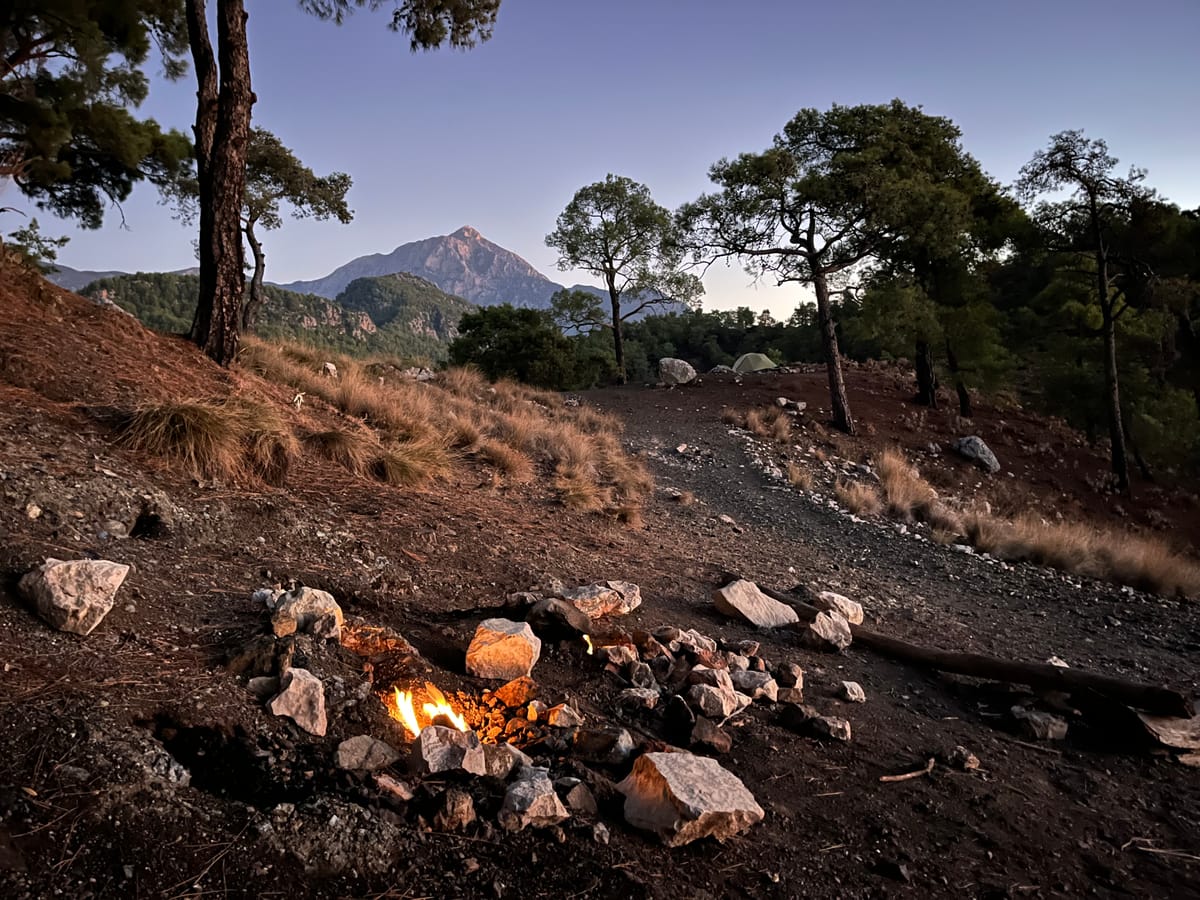
Short version
This week brought plenty of highlights that drew other travellers too: Myra, Olympos, the fires from the underworld, and the Gelidonya Lighthouse. We also had long, lonely elevation gains and crossed the Tahtalı Dağı pass, the highest point of the trail — plus another sick day. Inspired by a turtle and our simplified life (walk, eat, sleep), we realised we’re at home in the now, because we have everything we need.
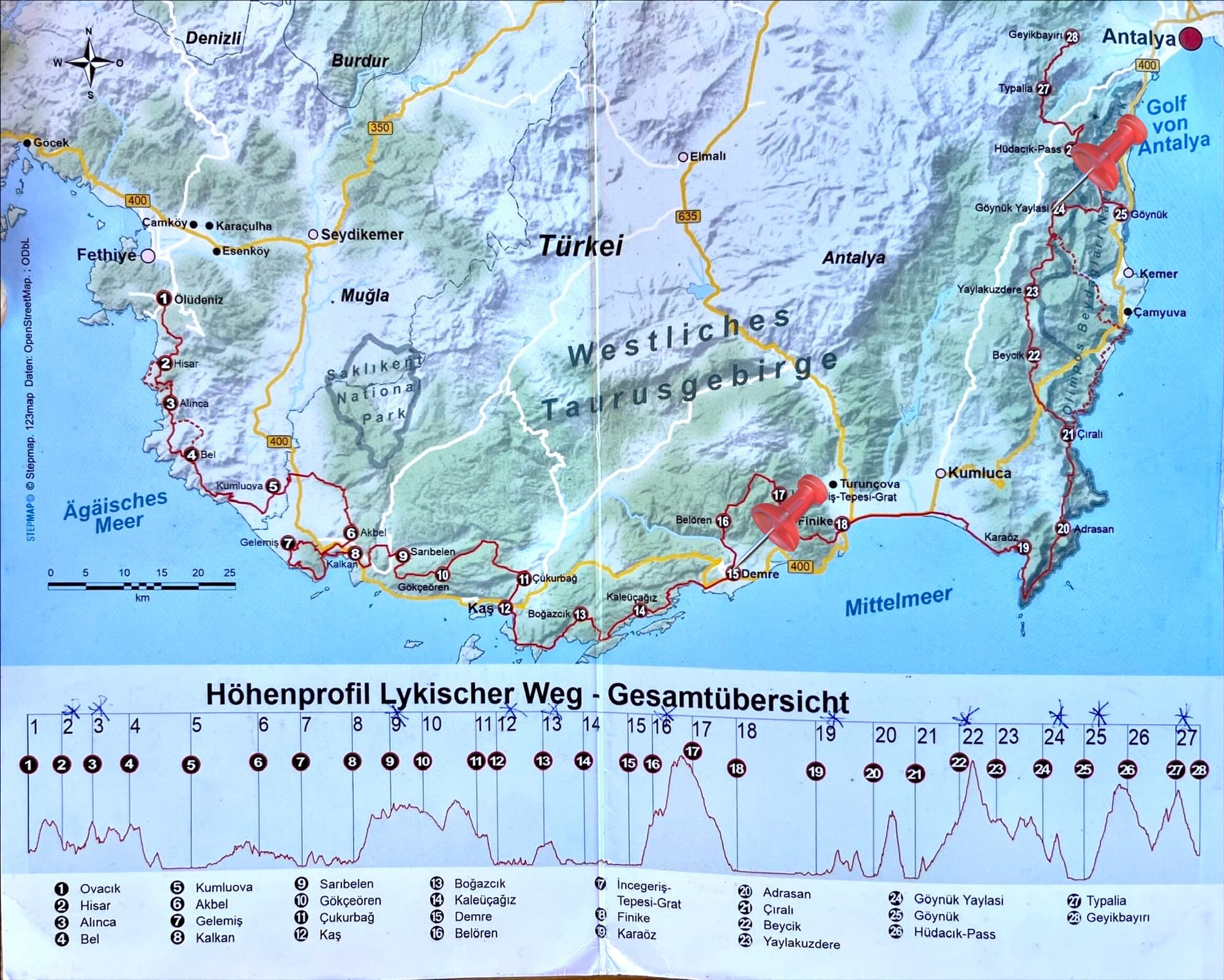
Setting off from Demre and arriving in Belören
Leaving Demre needed a bit more of a push — even though we both went to a paediatrician again here (pretty pointless, but that’s another story) and called our paediatrician in Zurich (great). We left the Church of St. Nicholas behind and looked at the ancient city of Myra from the road while ChatGPT told us about it. There were still 700 metres of ascent and 9 km to Belören, so we headed inland and uphill, leaving the sea behind with a pomegranate juice in hand.
Amid the sea of greenhouses, the noisy 90s cars and dromedaries (or camels), we left the scare of the illness behind, step by step. Halfway up we met a Russian hiker and asked him how the trail had been — three mountain stages were coming up that many people skip. He just said: “Hard” and “Now drink.” Whether that was his English or a lack of words… who knows.
A little later we met a hiker from Tasmania (the fourth Tasmanian on the trail!), with whom Ivo had eaten two days earlier. He said he was sick and had vomited, planned to walk slowly to Finike, and had allowed five days for it. We kept going — the trail was easy, though steadily uphill. We had planned two nights.
Clouds have been decorating the sky since these days, sometimes darker, sometimes lighter, and it’s no longer too hot. When we reached Belören we saw donkeys, goats, chickens and turkeys — and a volunteer fire station. With hands and feet we understood the firefighters telling us it would rain in the evening. We asked where we could sleep, and they pointed to a building opposite the station.
Inside were several rooms with stacked chairs, a few 90s monitors and a toilet — maybe a community or multipurpose hall. We were happy to have found it: the village offers no infrastructure, just a few farmhouses. How kind that we could sleep here for free! We had no mobile signal.
A little later the Tasmanian hiker joined us; while we slept inside, he slept on the terrace. In the evening we drank çay with the firefighters and chatted — Cleo was topic number one. We’re kind of trail celebrities: the Tasmanian had heard of us before he met us.
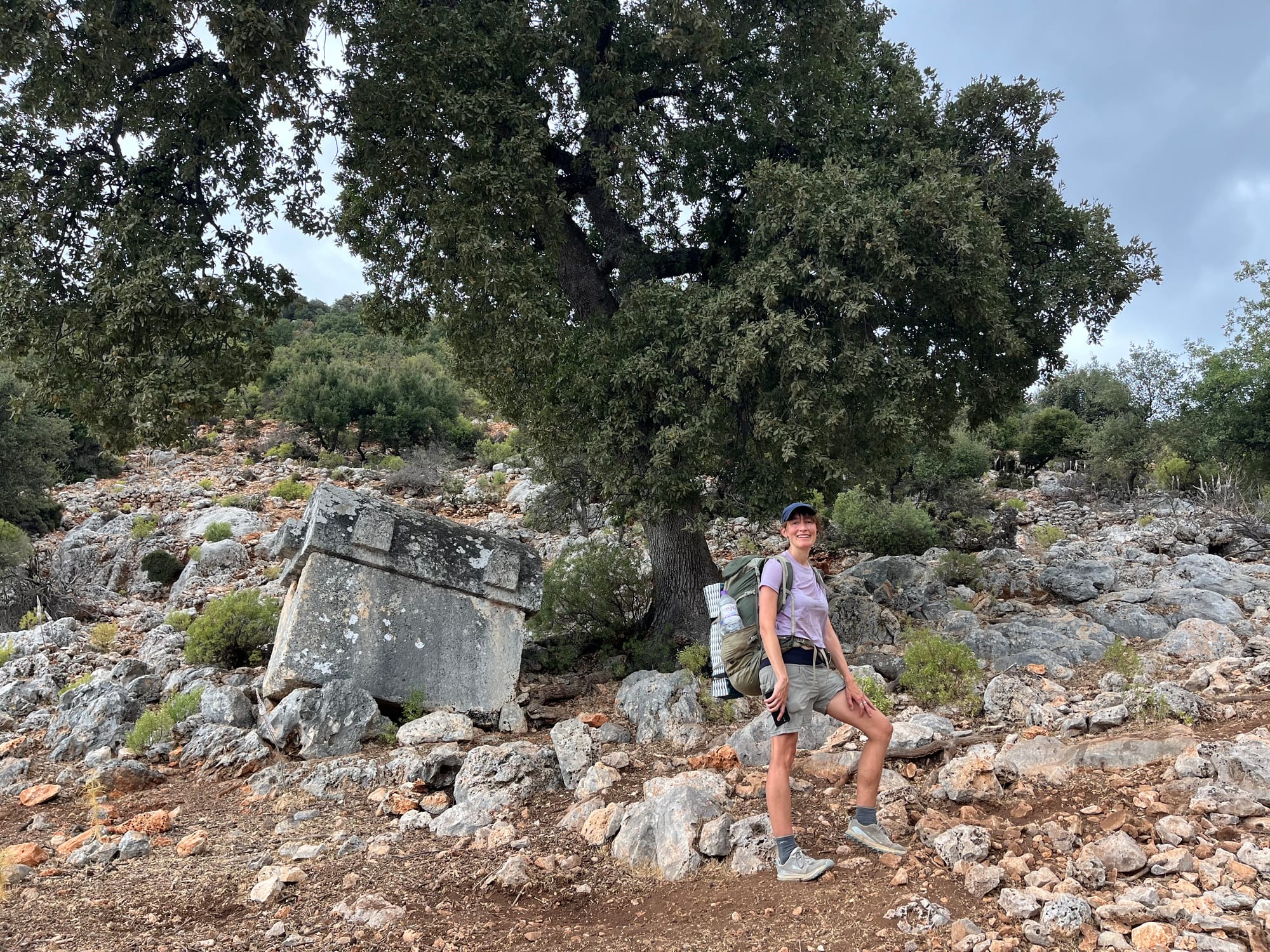
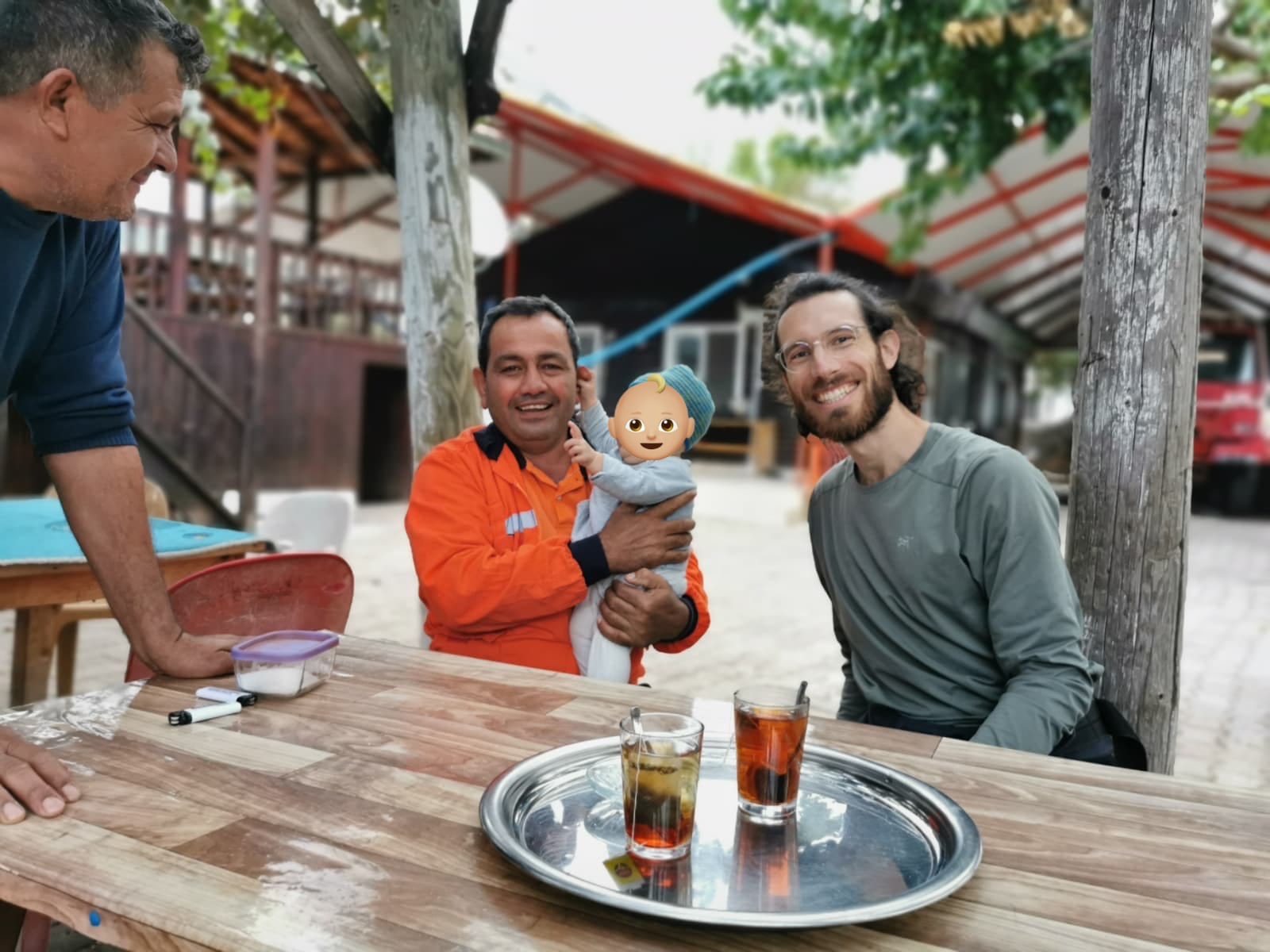
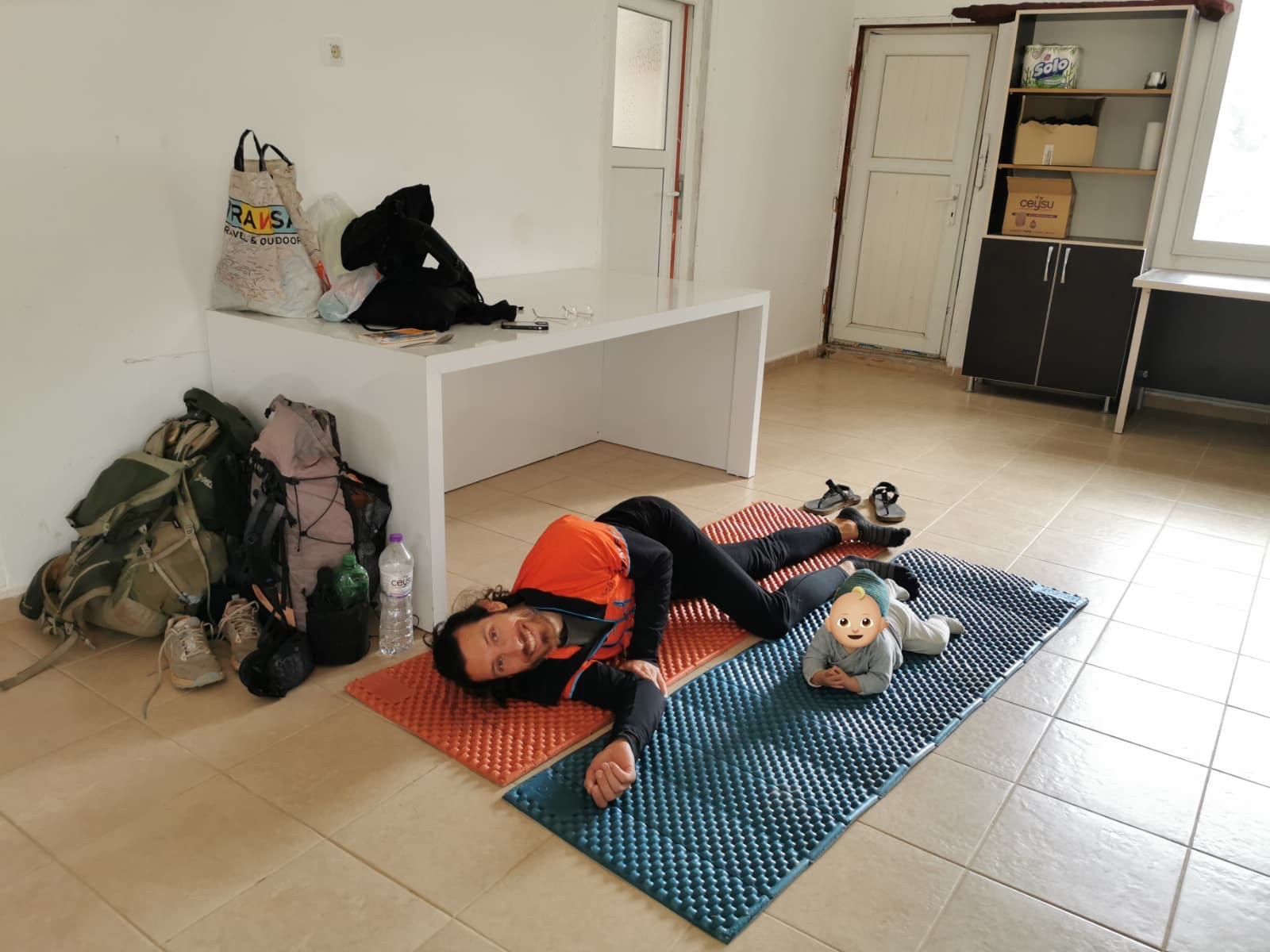
On narrow paths and through canyons
The night was quiet and we slept well. Woken by the crazy roosters from 4 a.m. and another Australian who took a taxi up, we set off at 6:30 with the first sunrays after our muesli. We weren’t going to pass any settlements or fresh water that day, so we were fully loaded with water and everything we need for our simple life.
After the Tasmanian’s stomach problems from cistern water, we wanted to keep avoiding it. Up we went towards a 1,700 m pass. At first the path climbed gently to the ruins of a church, then it got steeper and required attention — partly because it seemed little used and was covered in goat droppings, partly because it disappeared between rocks and bushes.
We passed very simple shepherd shelters made of tarps and wood. All the more surprising to find a tiny tricycle in the middle of nowhere. The child it belonged to ran towards us beaming — apparently looking after goats with the grandparents. In the distance we heard unfamiliar shouts and calls to herd the goats.
Higher and higher we went, leaving the goat droppings behind. Past a beautiful rock formation we reached the highest point, took a break and realised we needed an extra layer — we were sitting in the middle of a cloud. The view was basically gone.
The stage could have ended there, but we didn’t want to sleep that high with Cleo (too cold), so we descended another 800 m, visited the ruins of Belos, another ancient city, and reached Belem by a fresh water tap next to the cemetery. A few Canadian hikers even slept in the cemetery; we pitched our tent just beside it.
We slept well again, and the next morning it was 8 km and 800 m down to Finike. One section was spectacular: an empty canyon of white rock leading towards the sea. In the last 24 hours we had eaten almost everything we carried (only the linseeds remained untouched; the strawberry-flavoured raisins didn’t make it), so a big breakfast in Finike was calling.
To be honest, the chance to indulge a bit felt pretty great — especially after days of spartan trail food. In Finike we ignored a severed chicken head on the street and headed straight to a breakfast café. Cleo got a warm welcome and, thankfully, was doing really well.
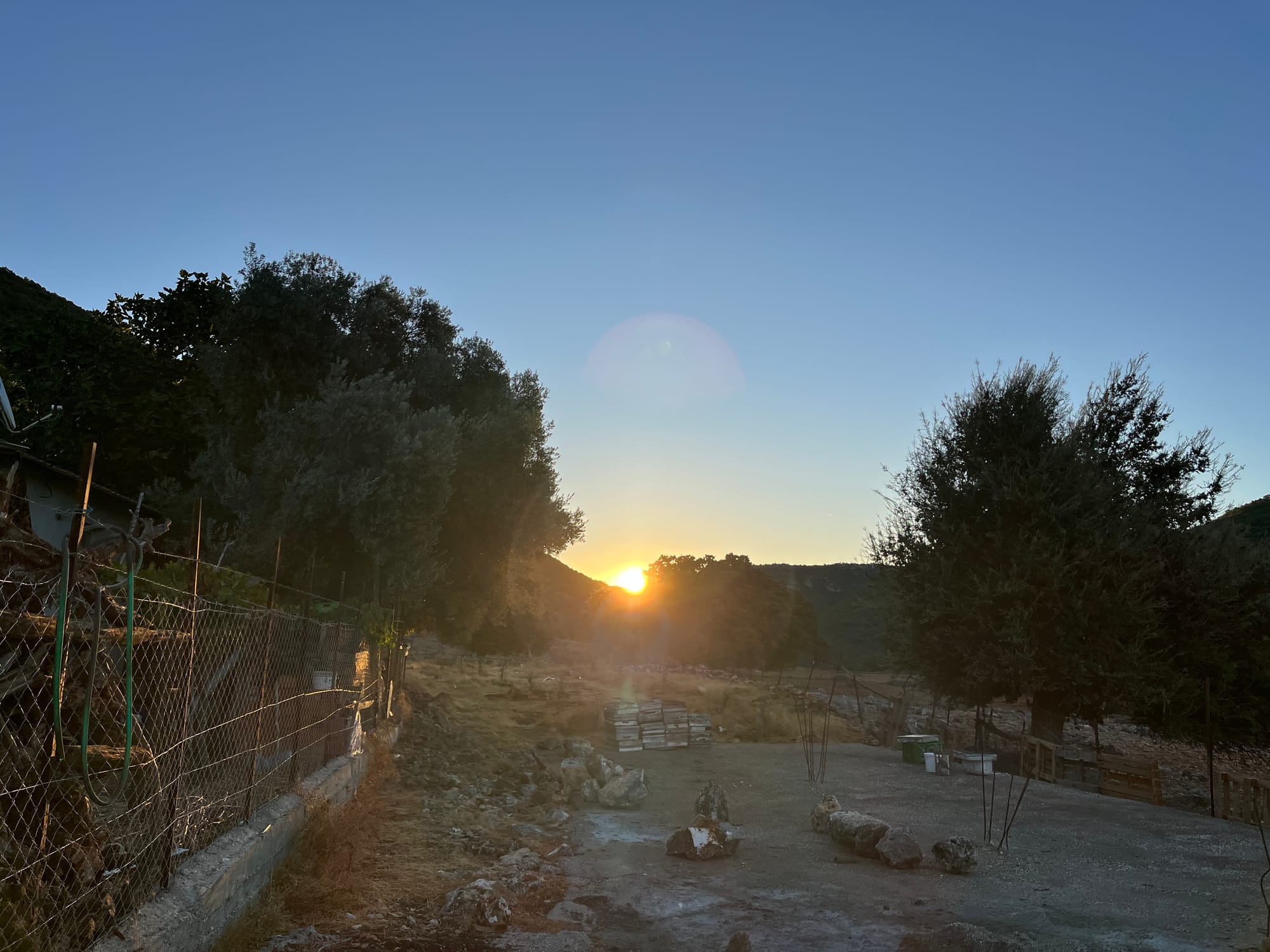
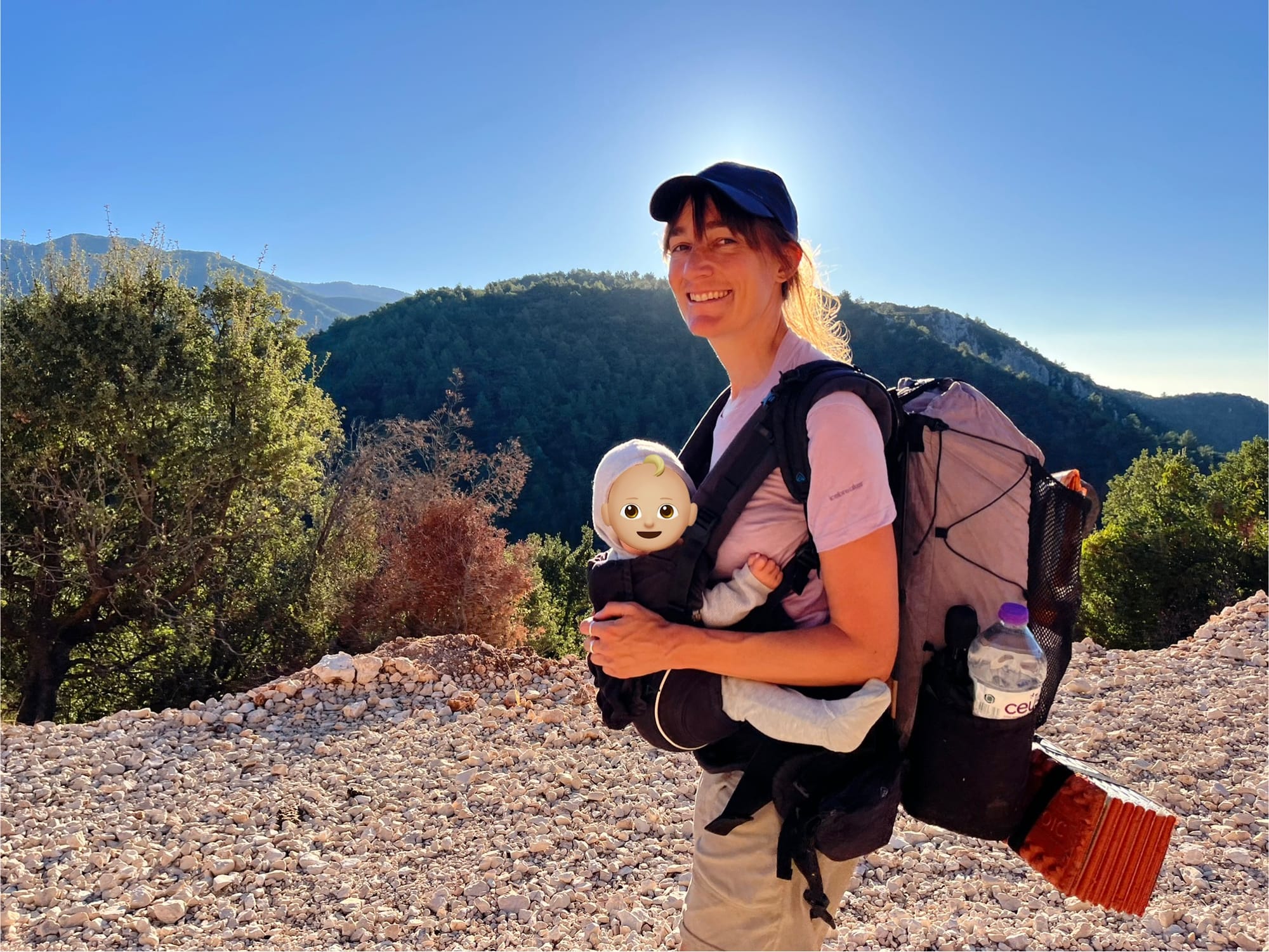
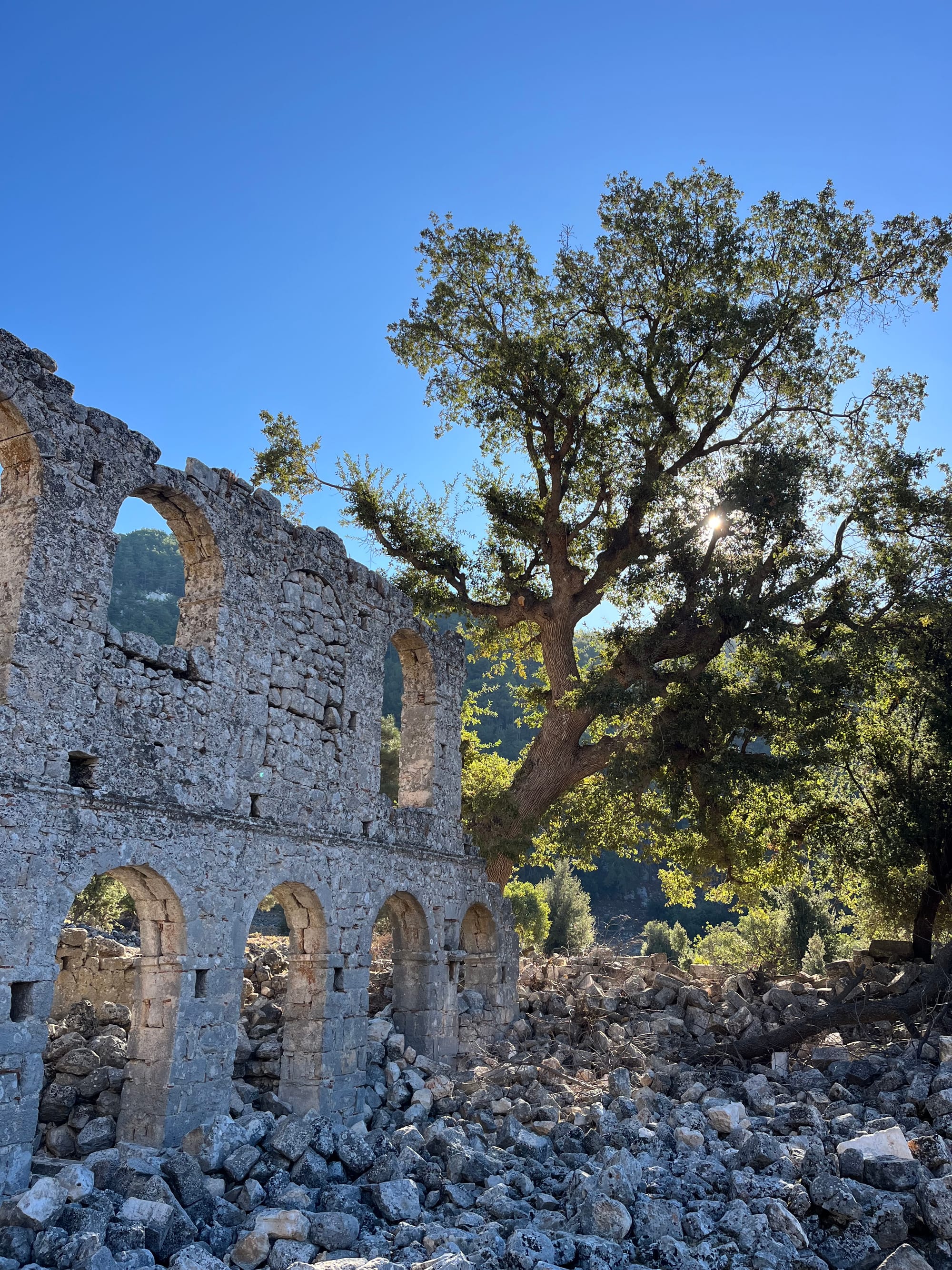
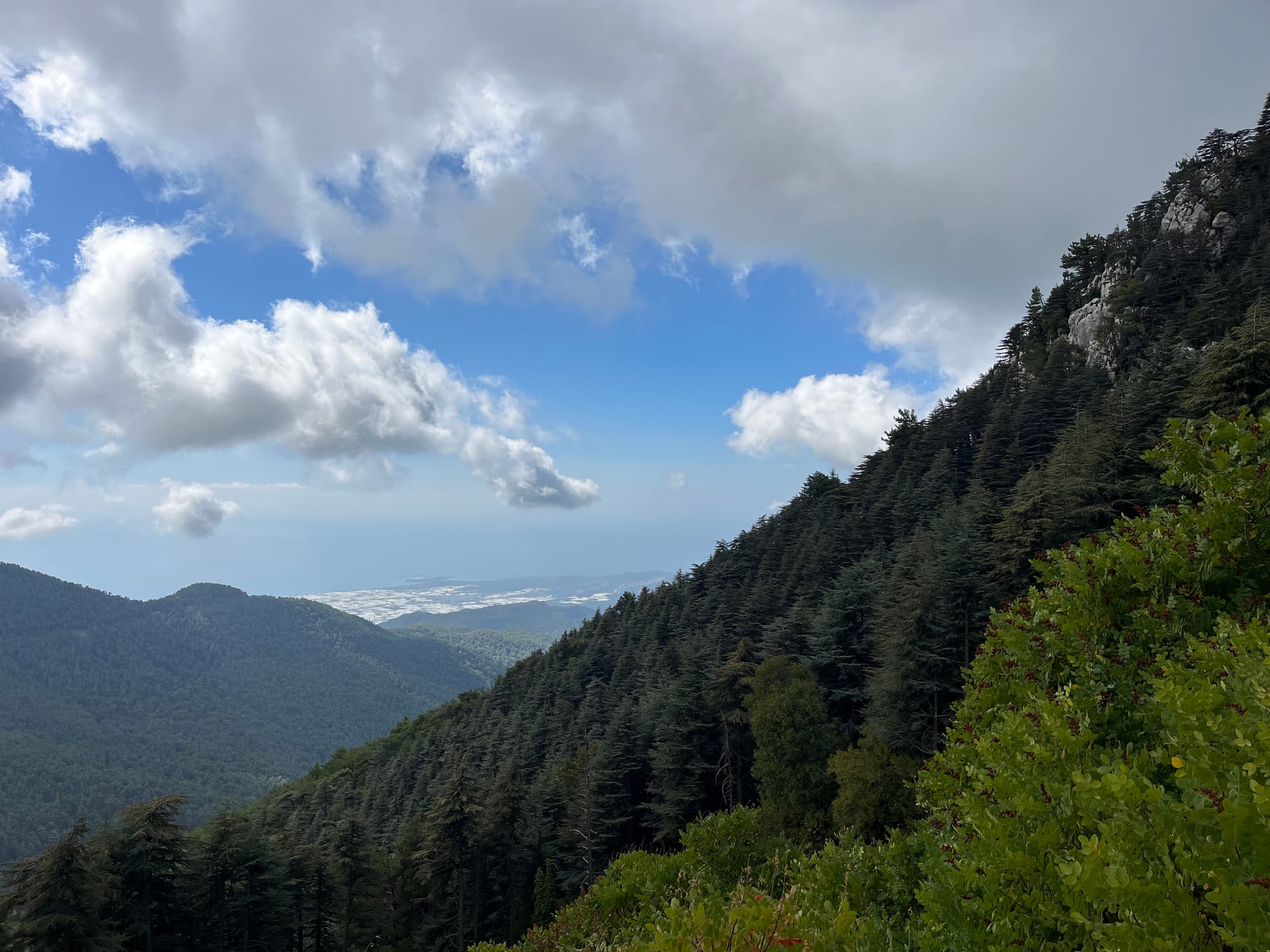
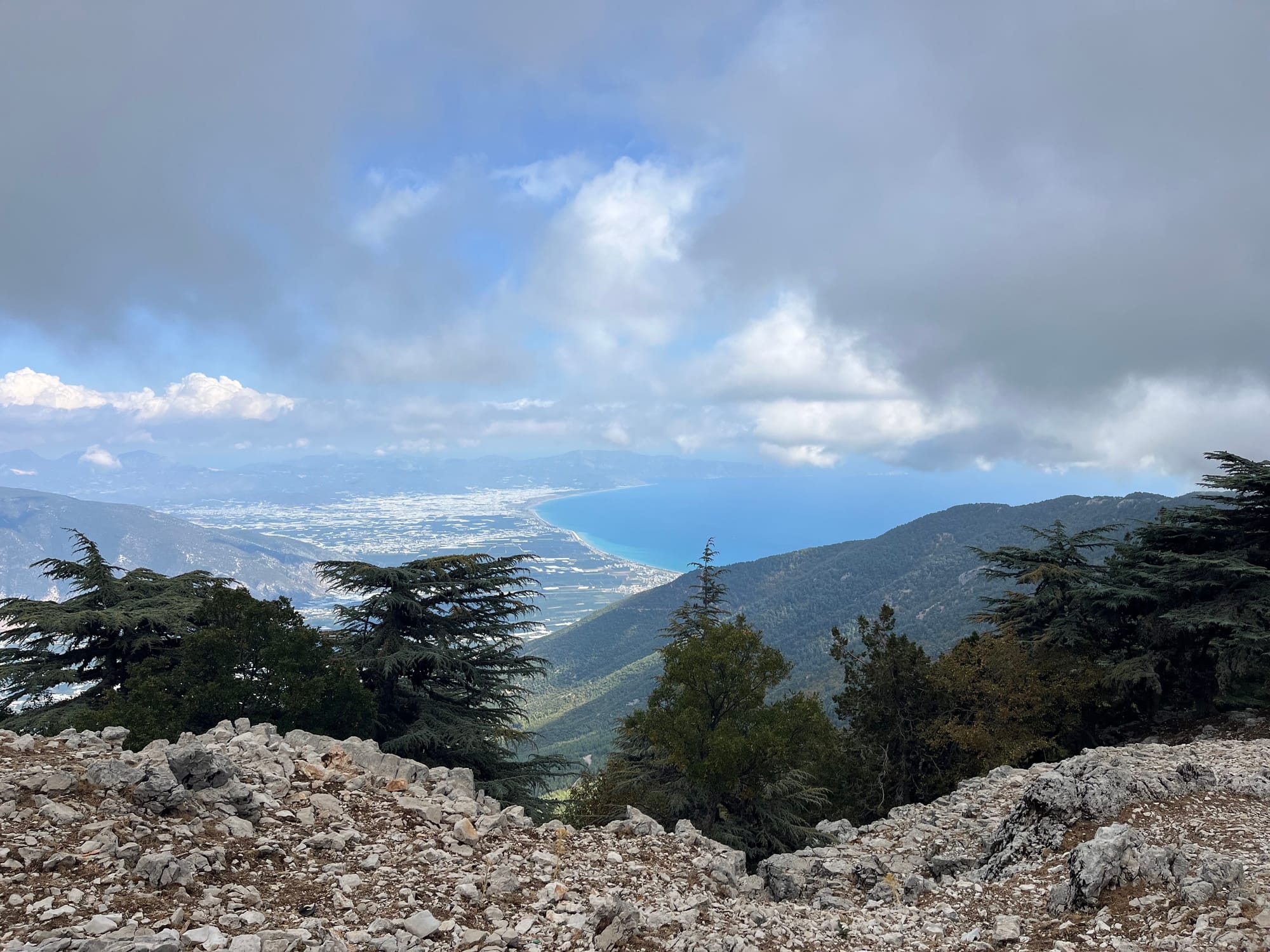
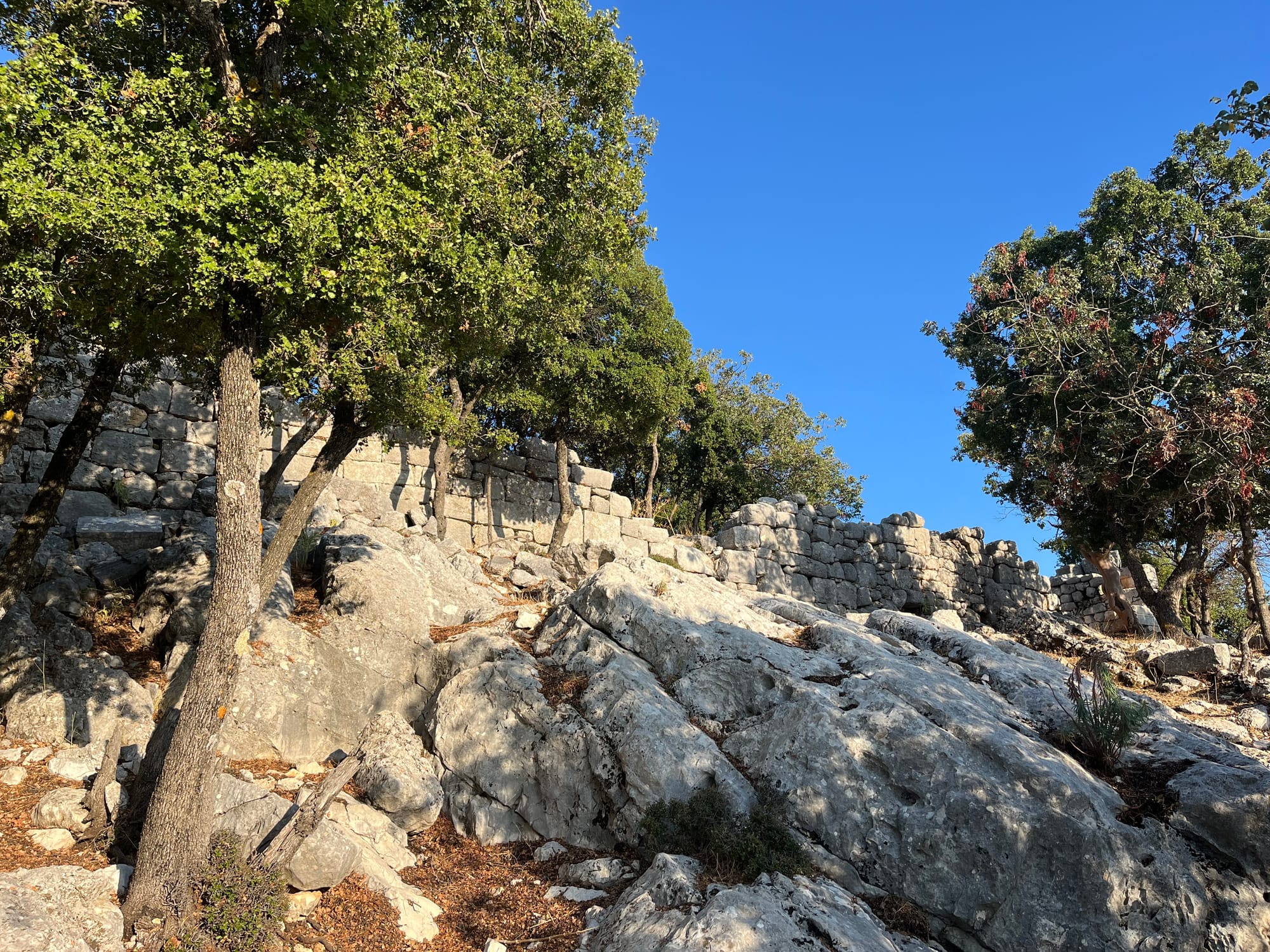
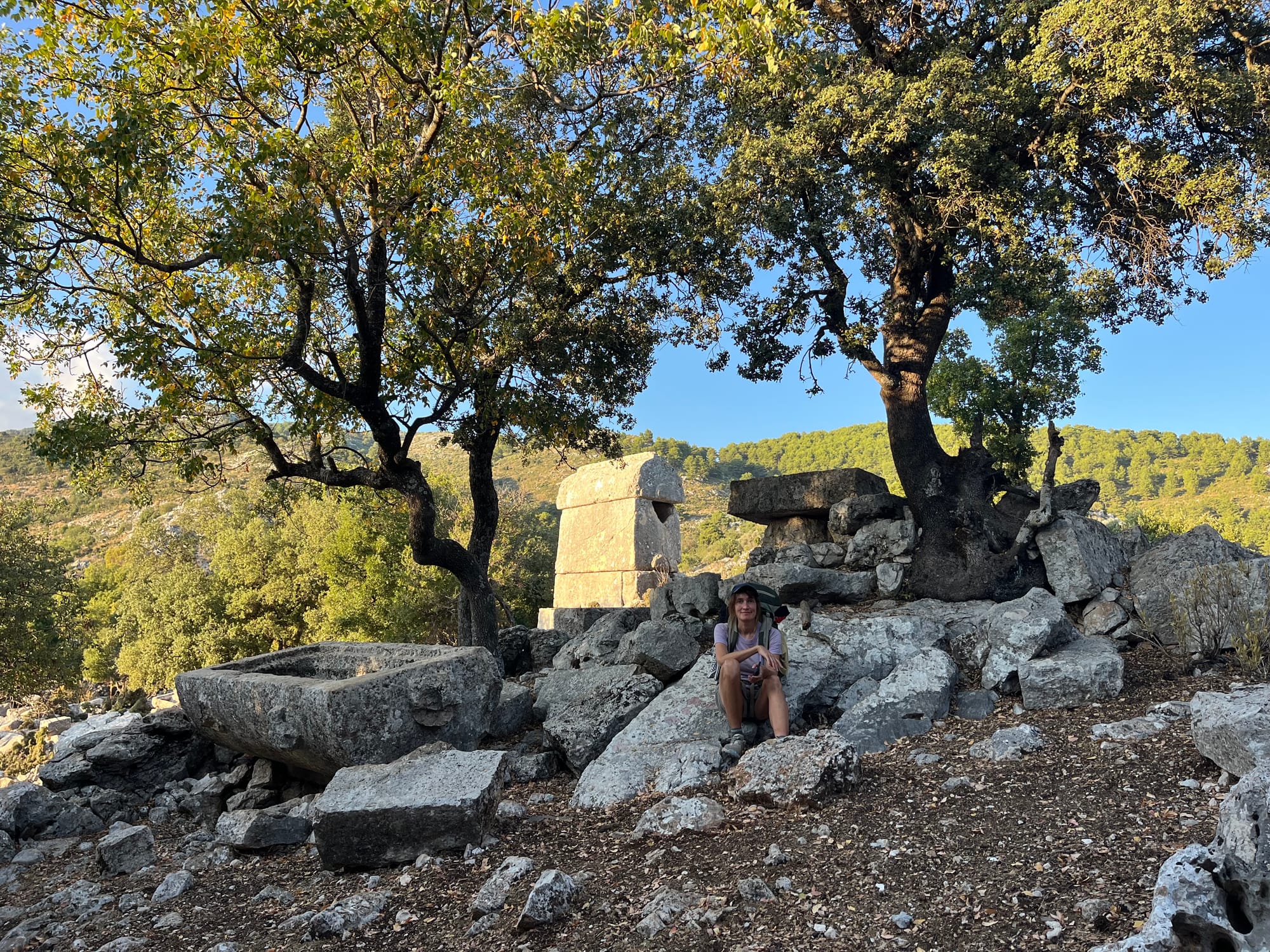
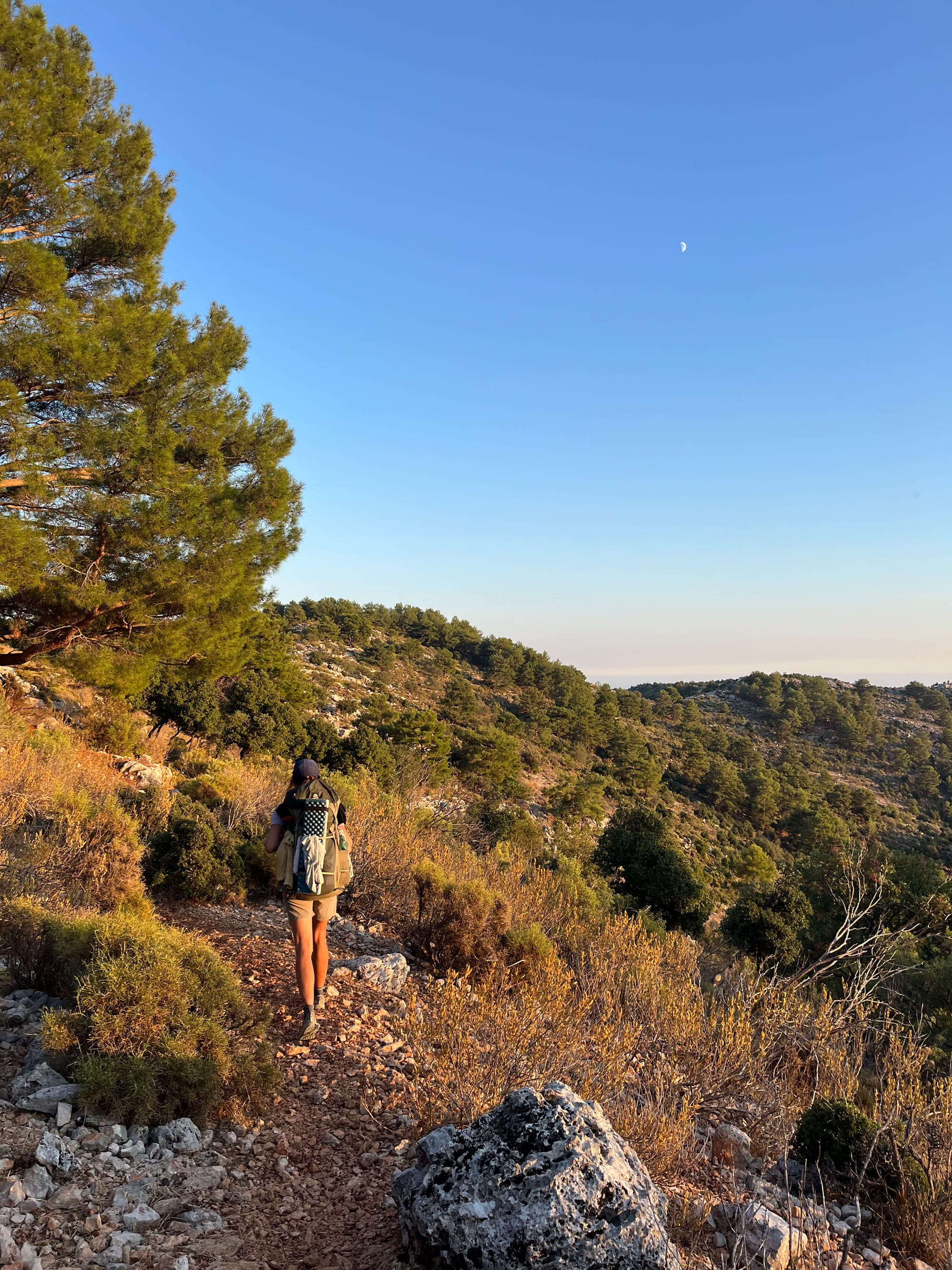
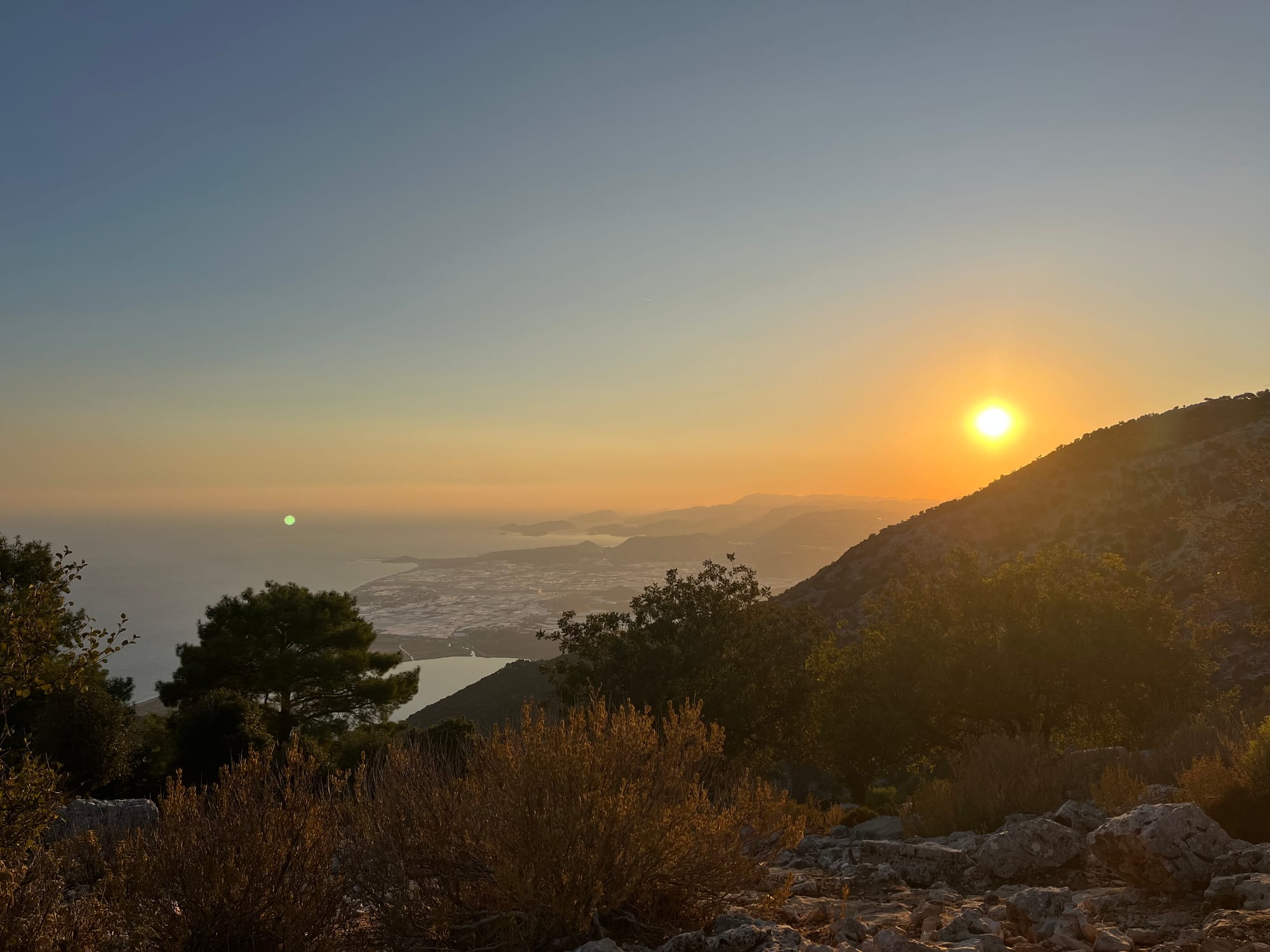
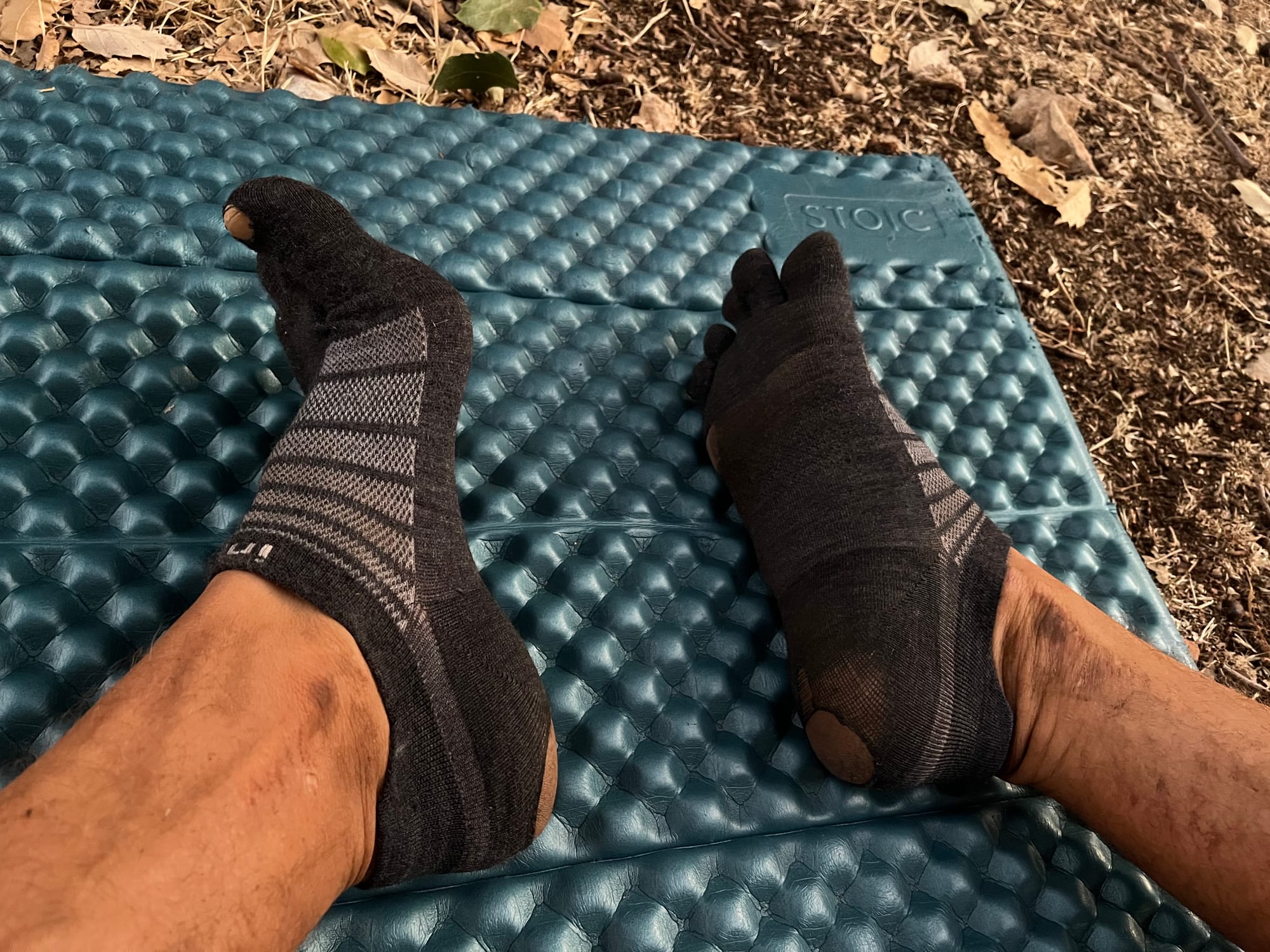
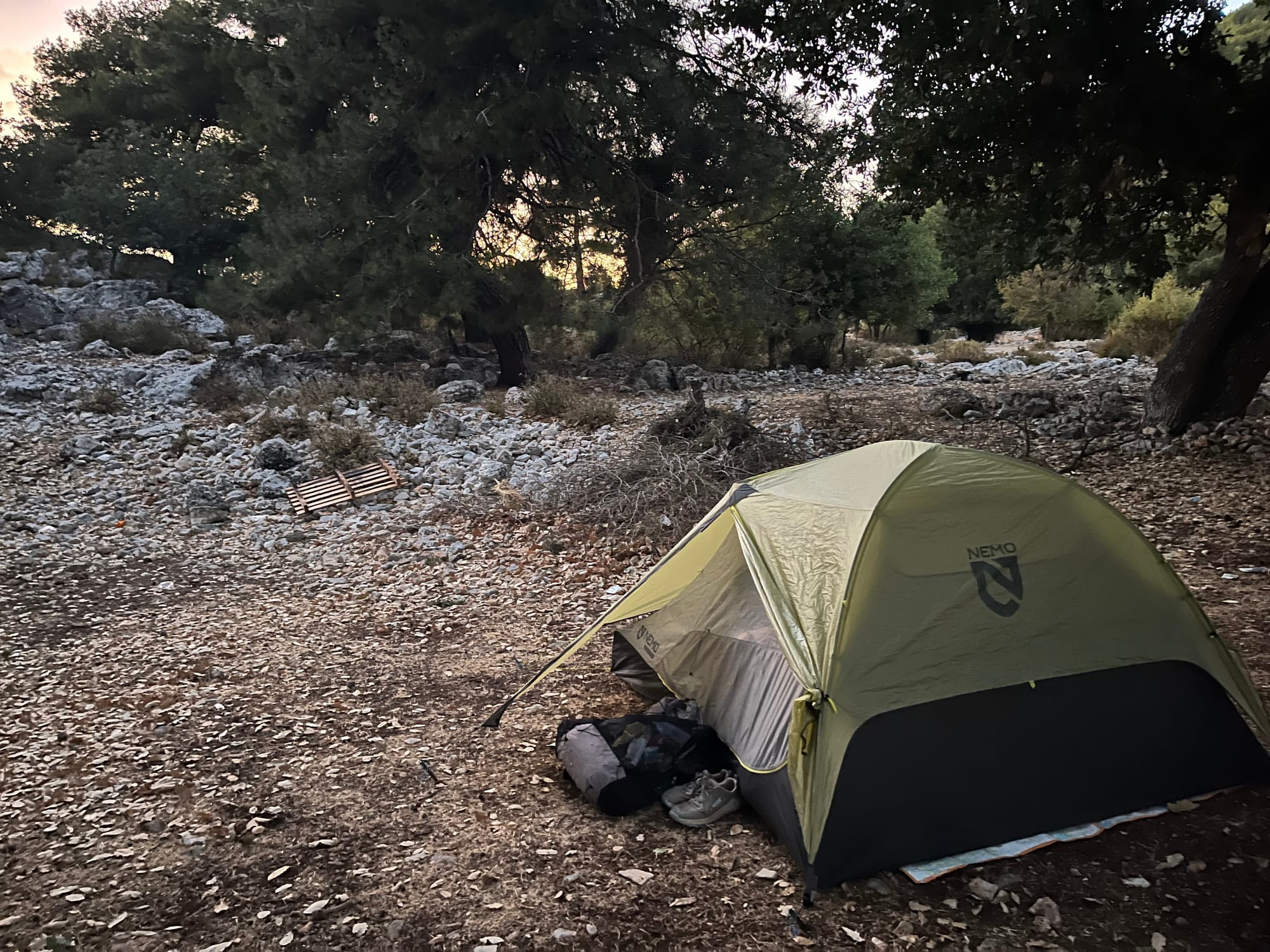
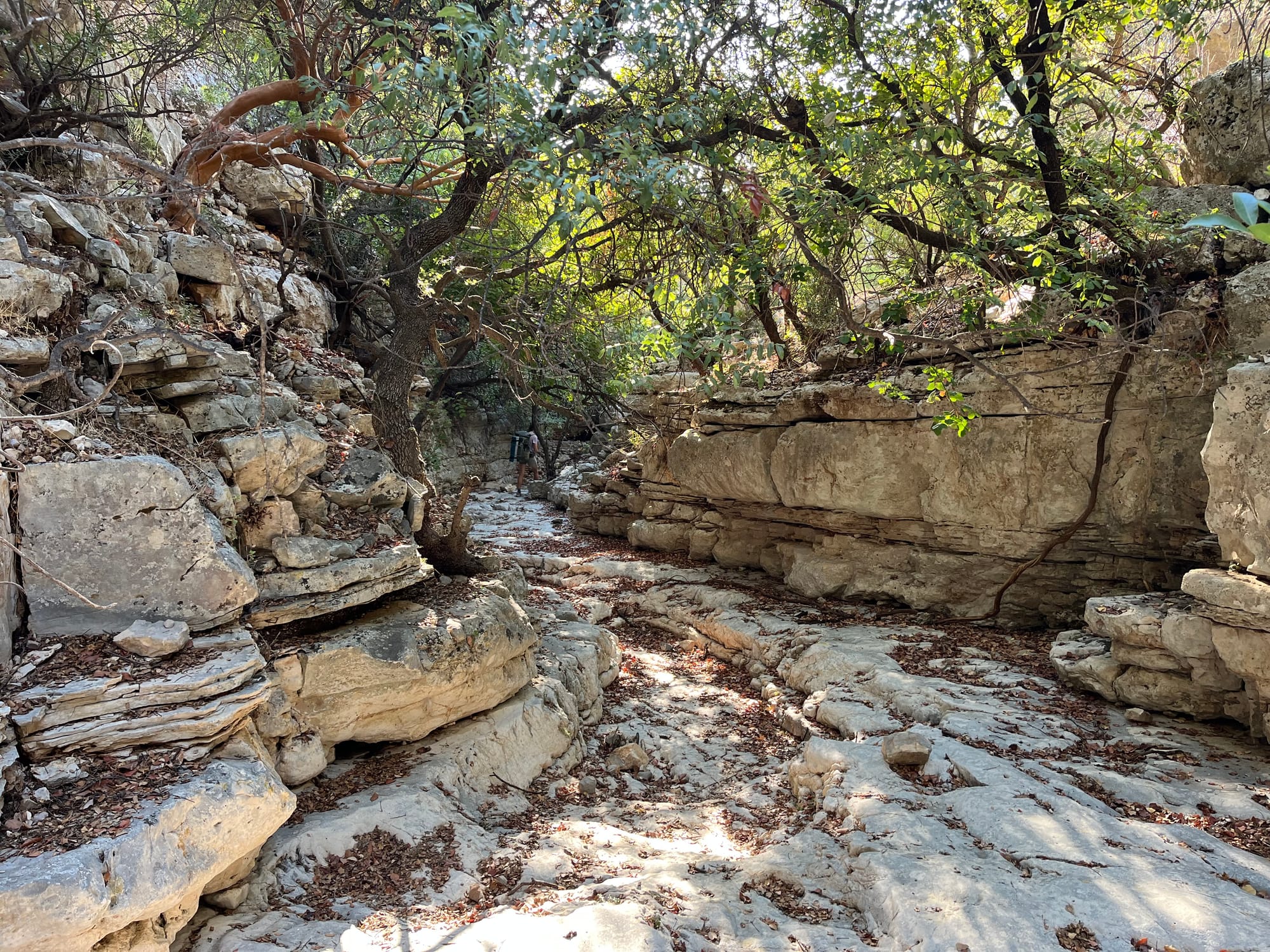
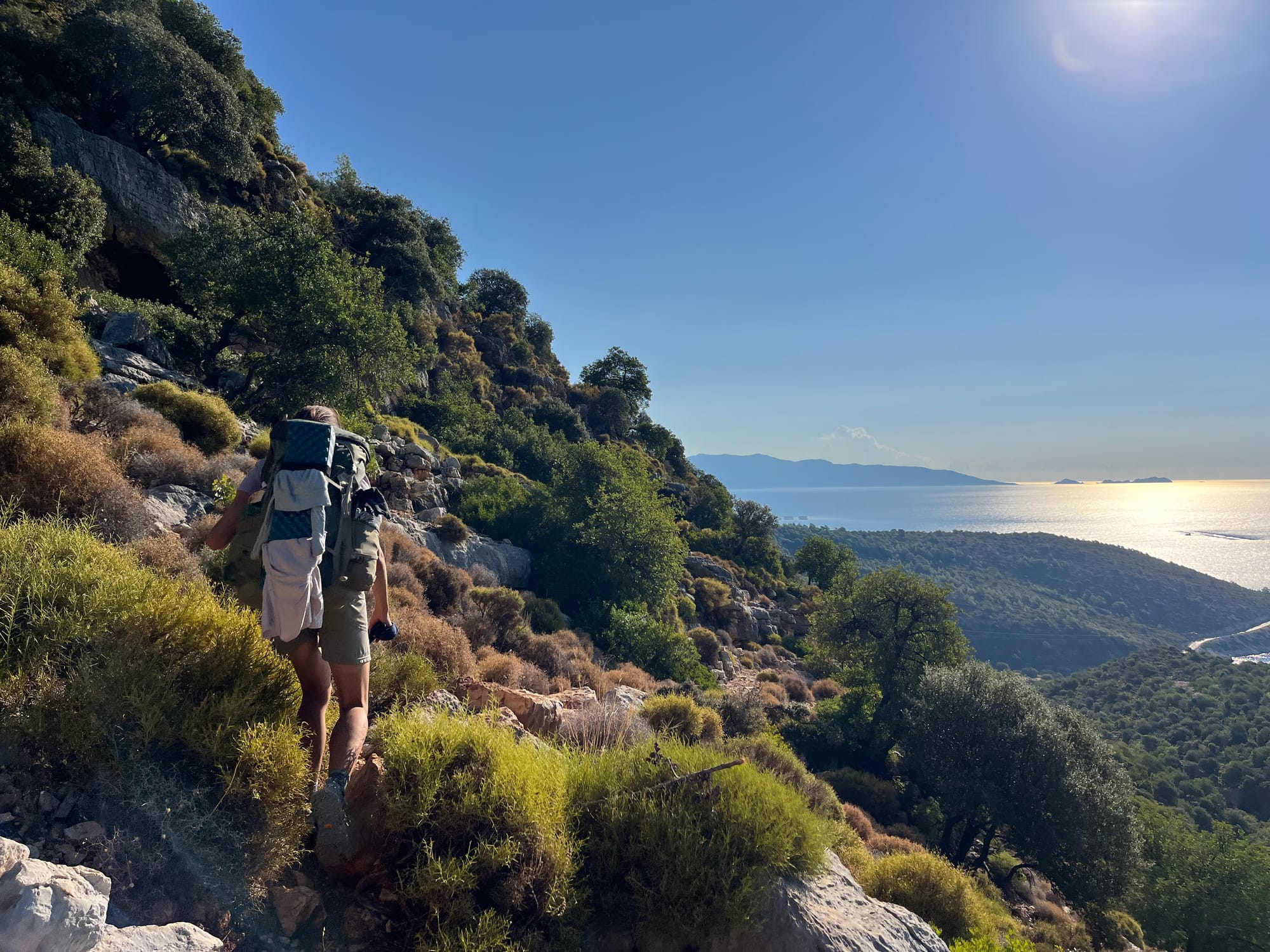
From the coast to Mavikent and Karaöz
The next stage was 30 km along the coast, mostly on asphalt. The upside: quick progress. The downside: sore feet and a bit monotonous. So we broke it up: a shower after 8 km, a supermarket 4 km later, and a restaurant another 4 km after that.
We passed signs warning “Watch out for turtles” — we only saw dogs; the nesting season is earlier in the year. The shower and a swim in the turquoise sea felt amazing. The supermarket had no fruit, so we settled for fruity ice cream and juice.
Soon Ivo’s foot started to hurt again, so over a very “authentic” pizza and pesto pasta we decided to walk just 5 km more to a spring and camp there. Past a luxury hotel with its own forest we arrived, with a gorgeous sunset, at the bay before Mavikent.
Many campers had set up here — no surprise: a beautiful spot, with a water tap. We were invited for a drink and sat with a family from Istanbul. The mother was delighted with Cleo — her own son is older — and joked with her husband about a second child.
They took photos with Cleo and us, and Ivo enjoyed himself — with a whisky and a cigarette.
The next morning, the fun was over: probably not just the whisky, but the cold catching up again. Ivo felt sick, so we only walked 6 km to Karaöz, past stunning coves.
At a stylish hotel we took Ivo’s temperature at breakfast and decided to stay. Over the next 20 hours he slept about 18; meanwhile Marie walked every street in town at least three times, cooked for Ivo and played with Cleo. Cleo was sweet, happy — and found a turtle. The division of labour paid off: the next morning Ivo felt much better and we could continue.
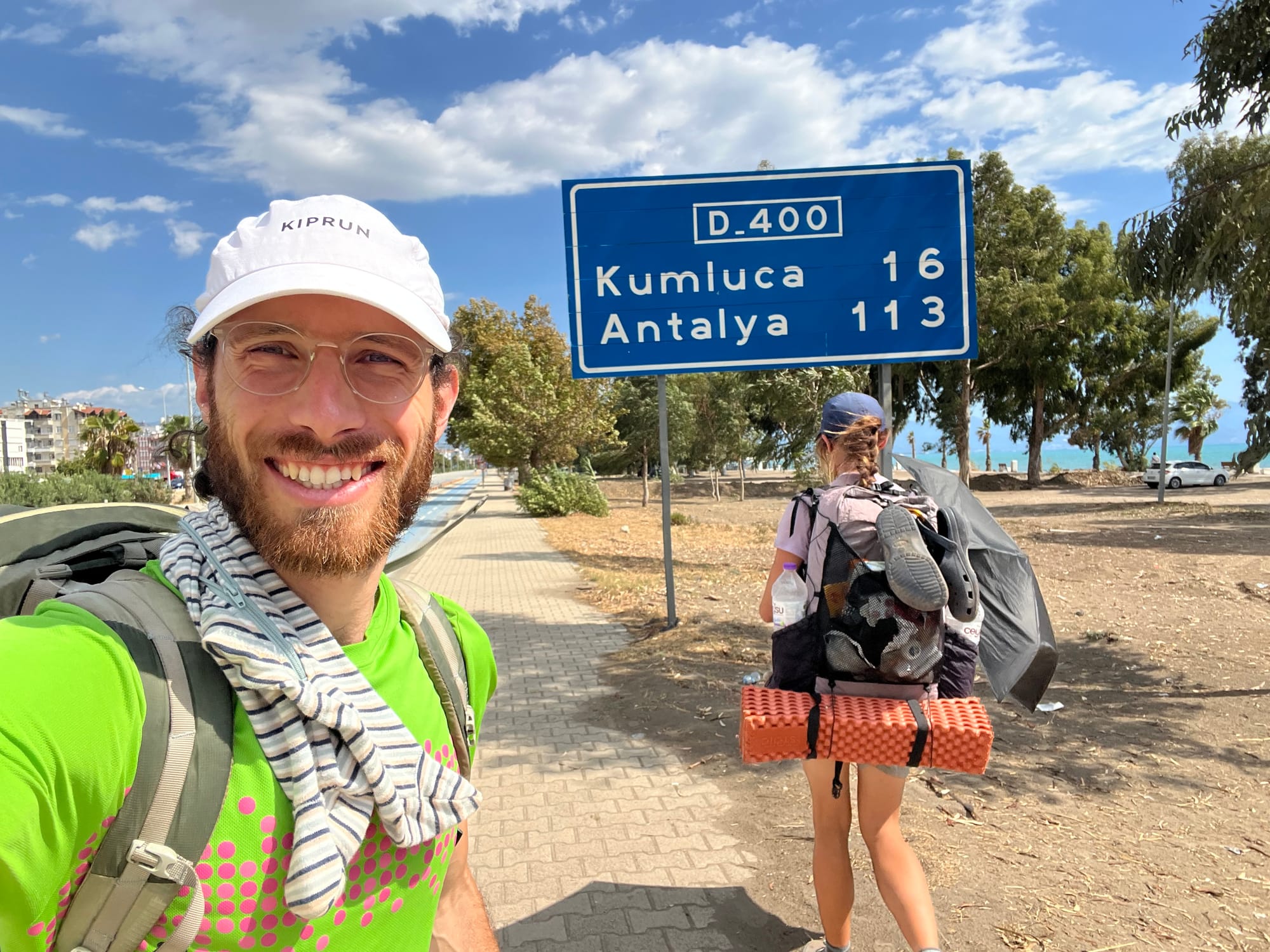
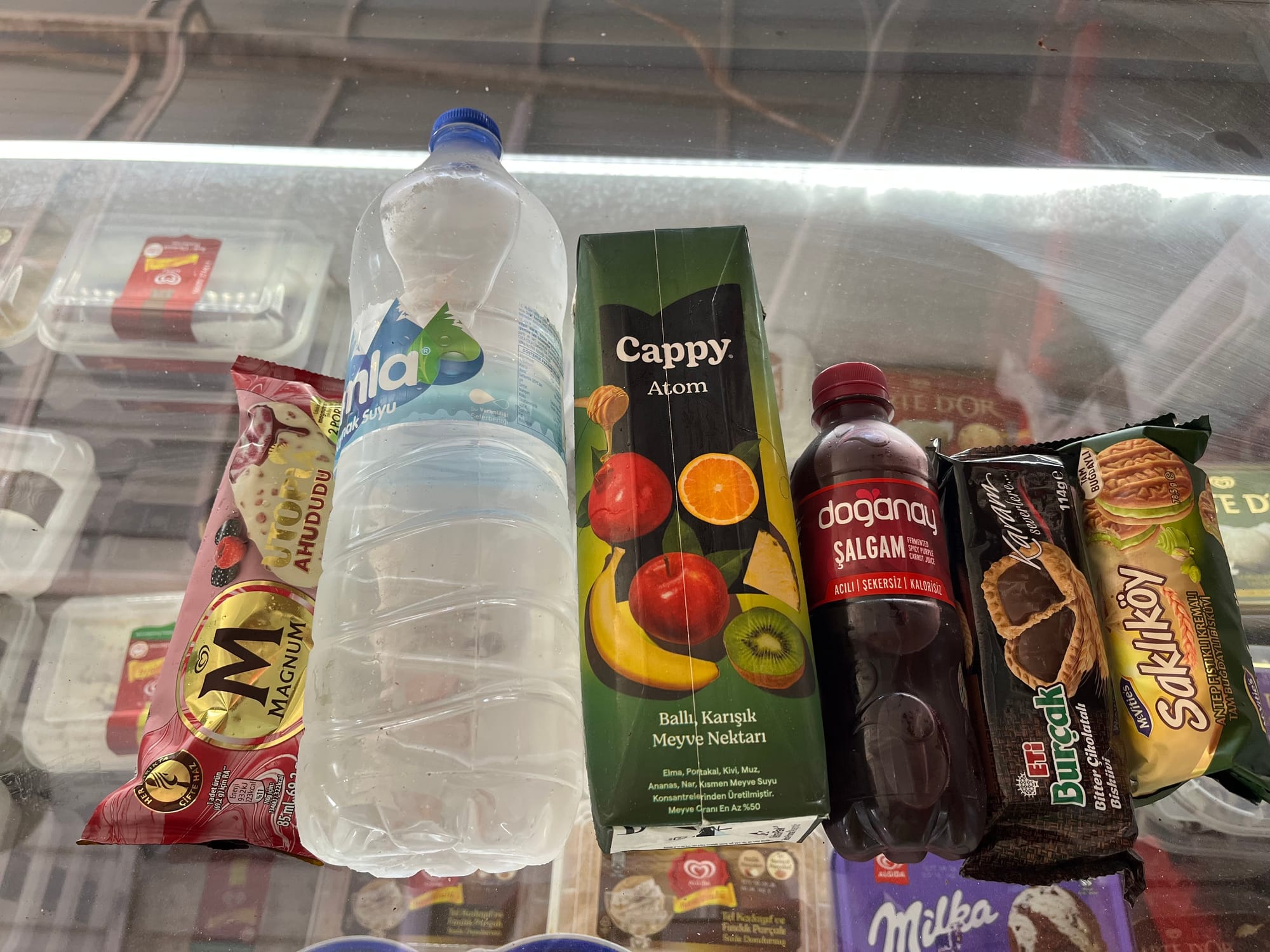
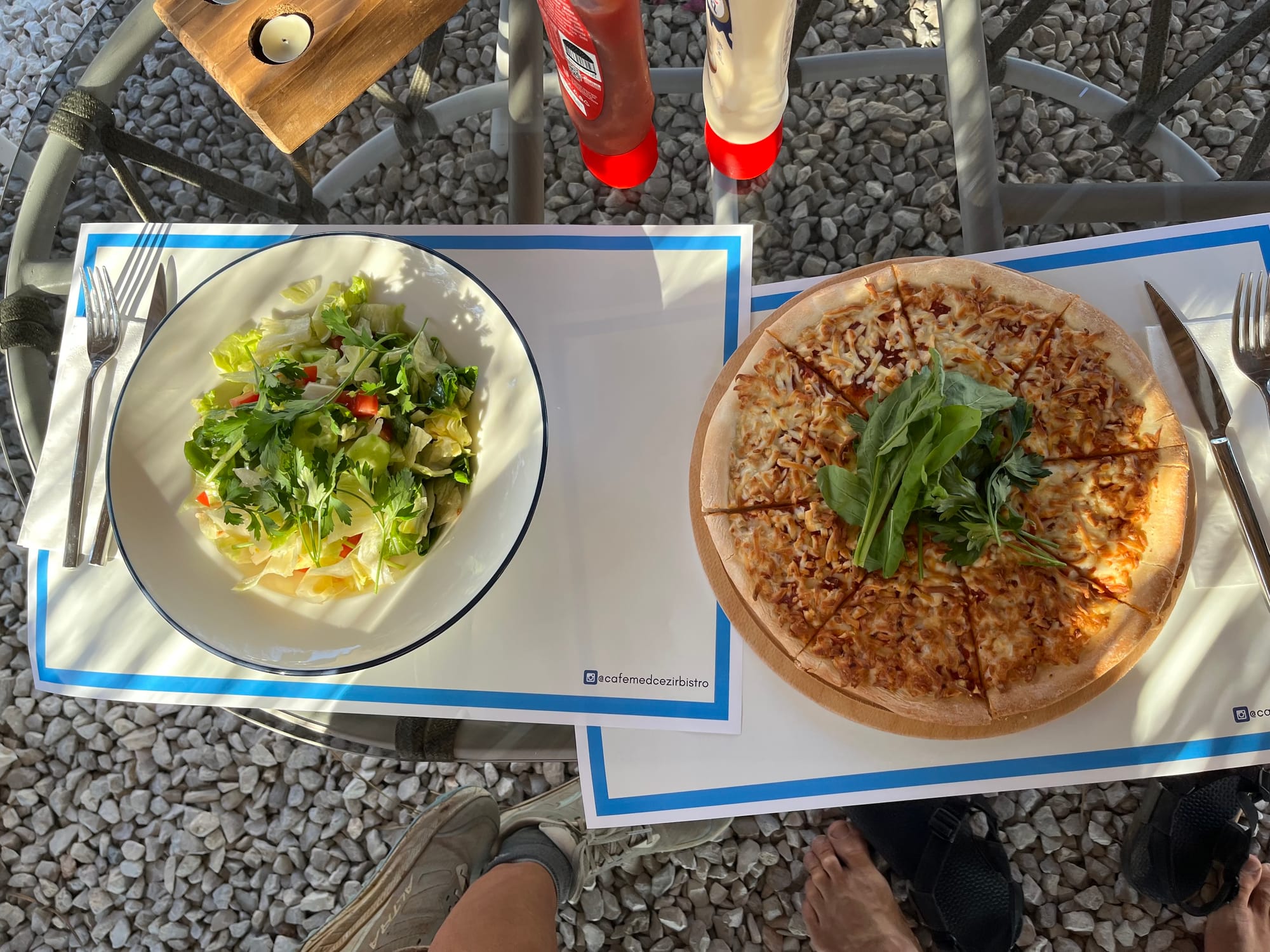
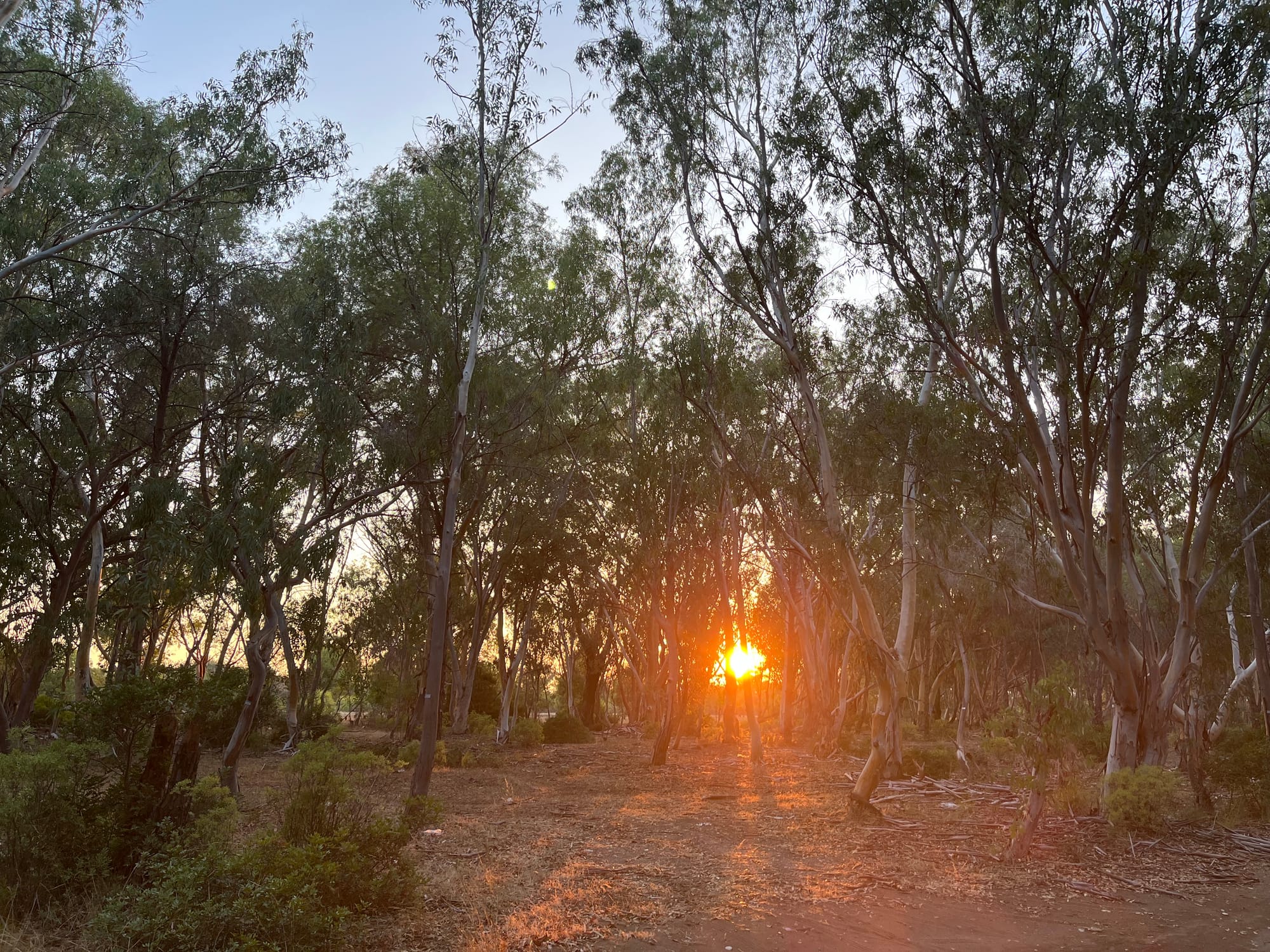
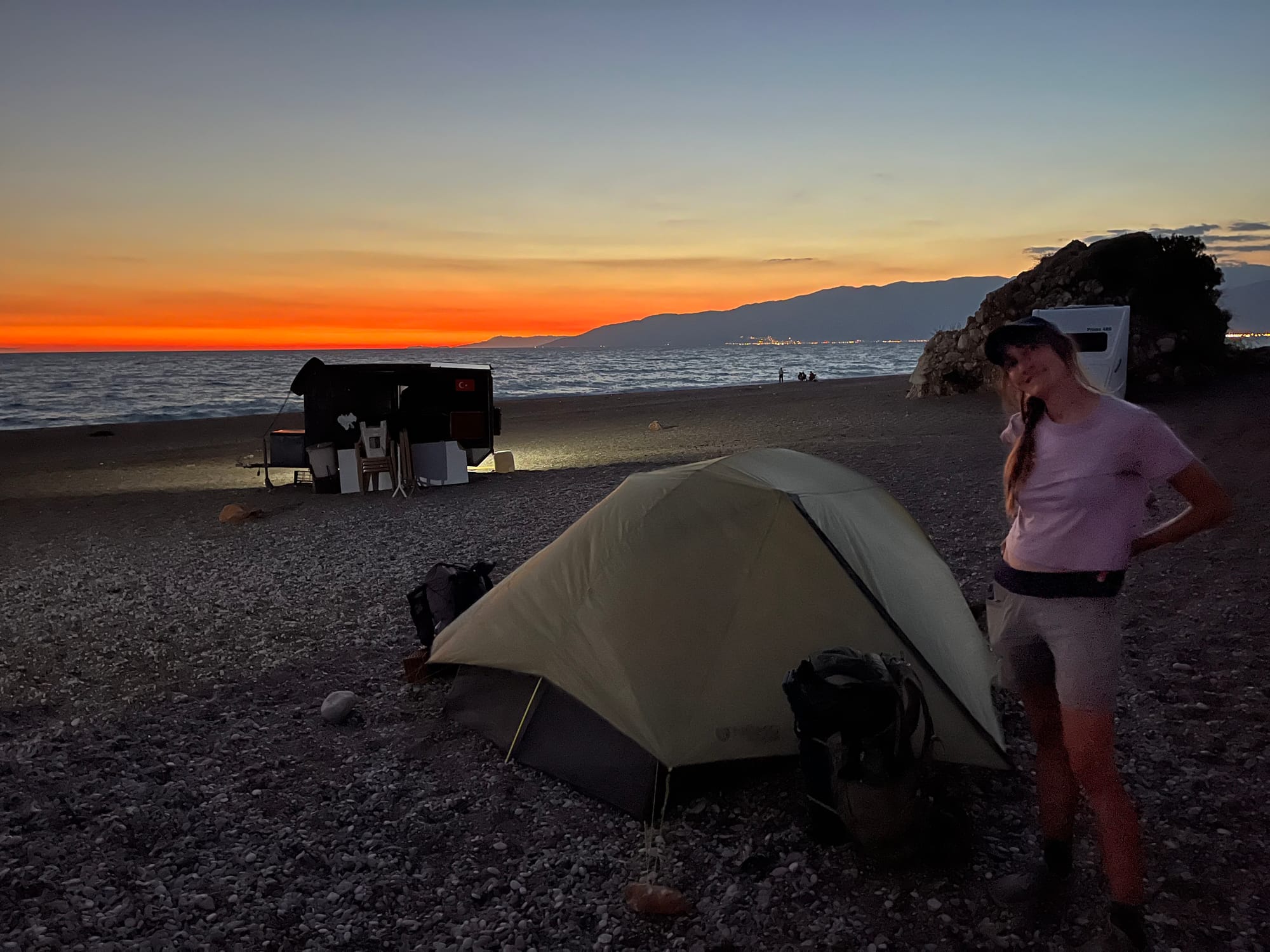
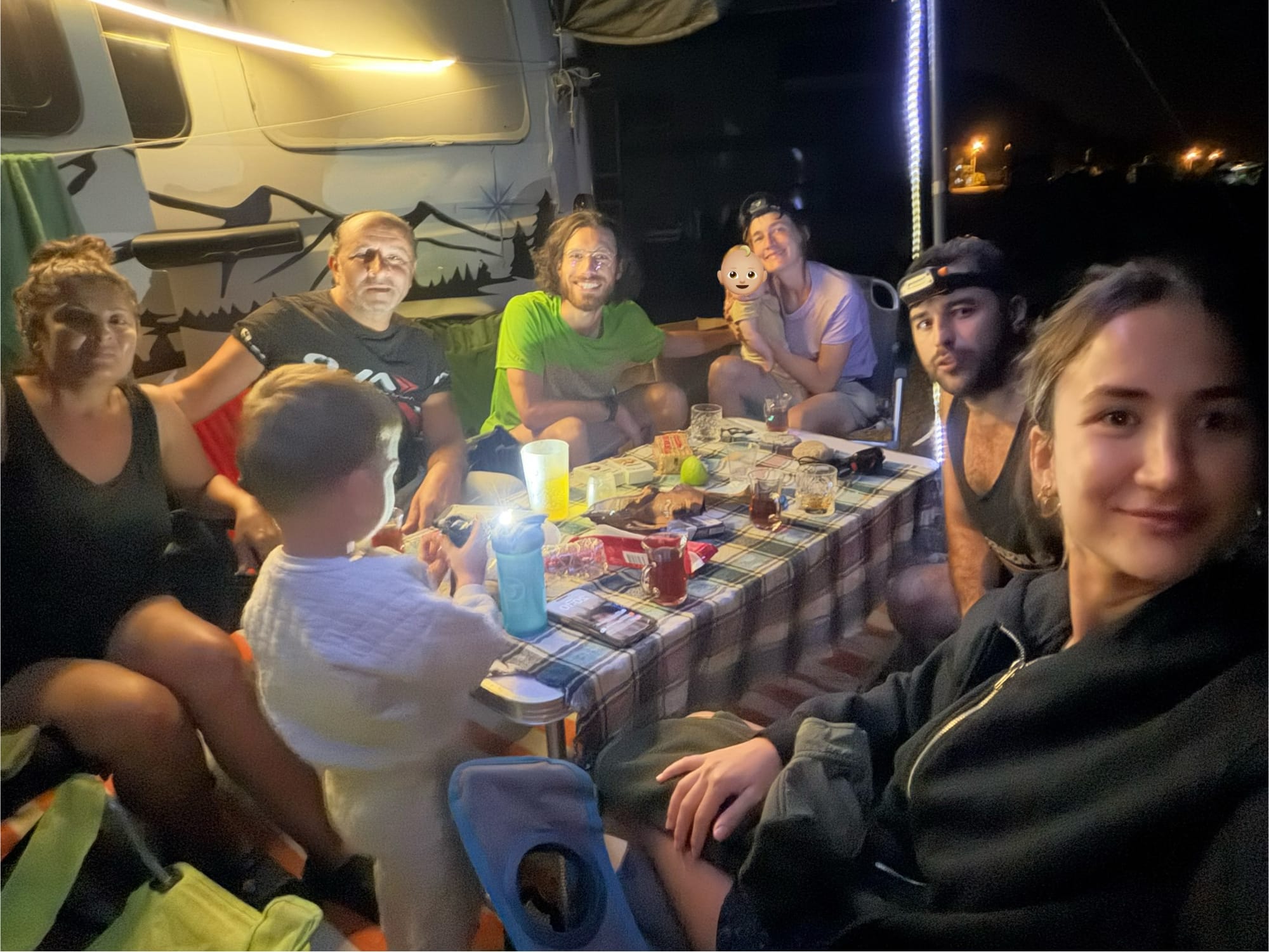
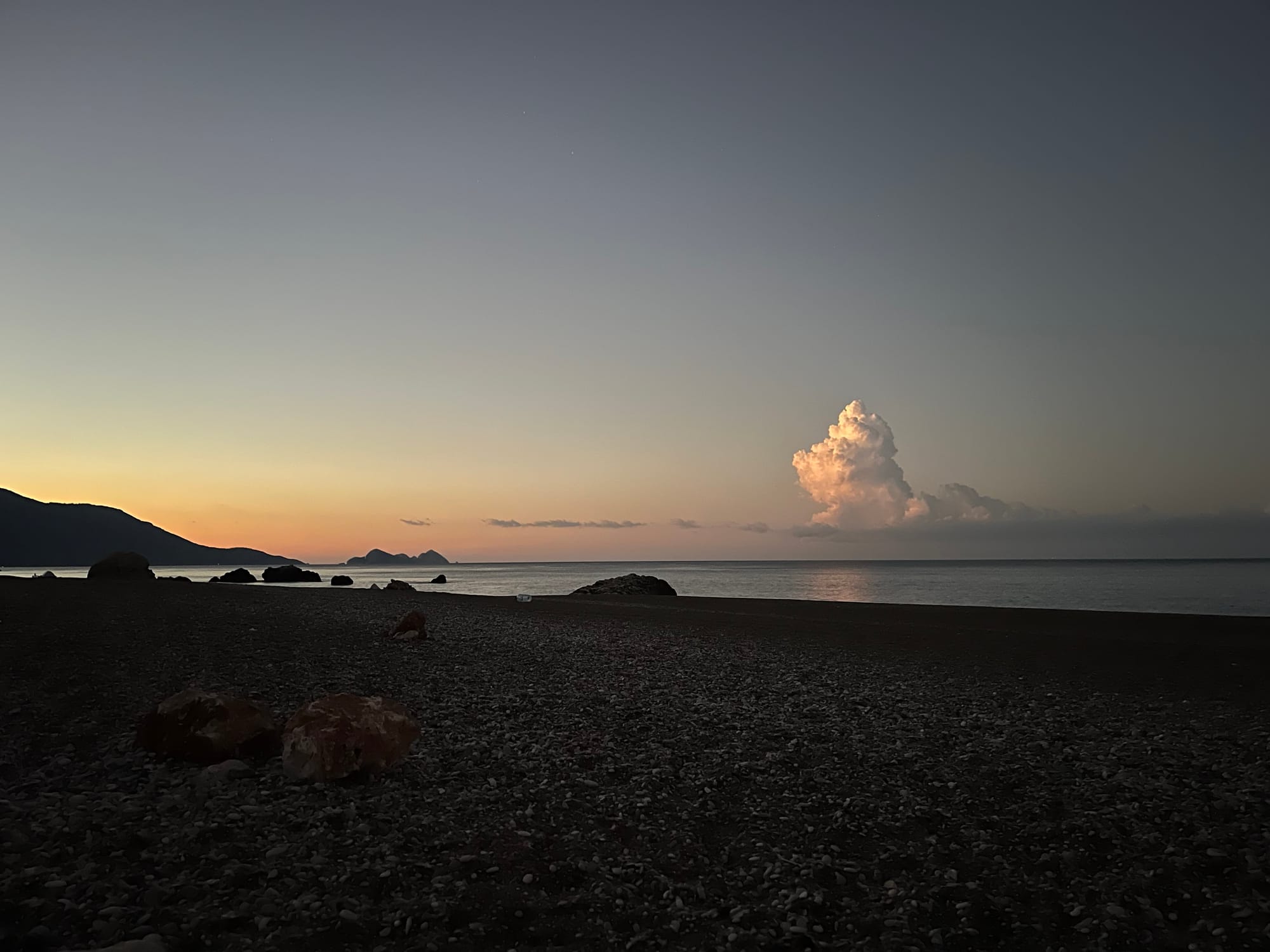
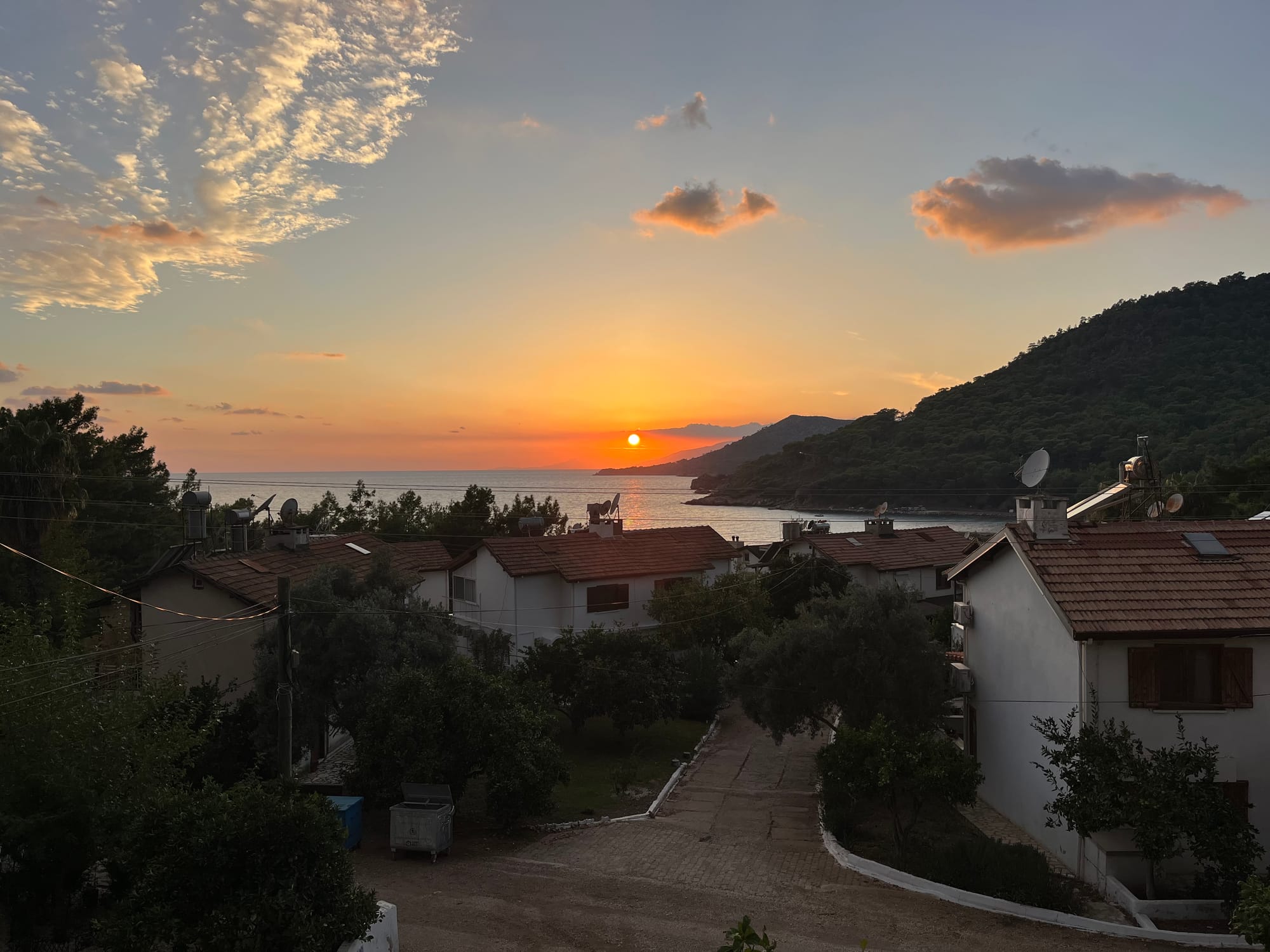
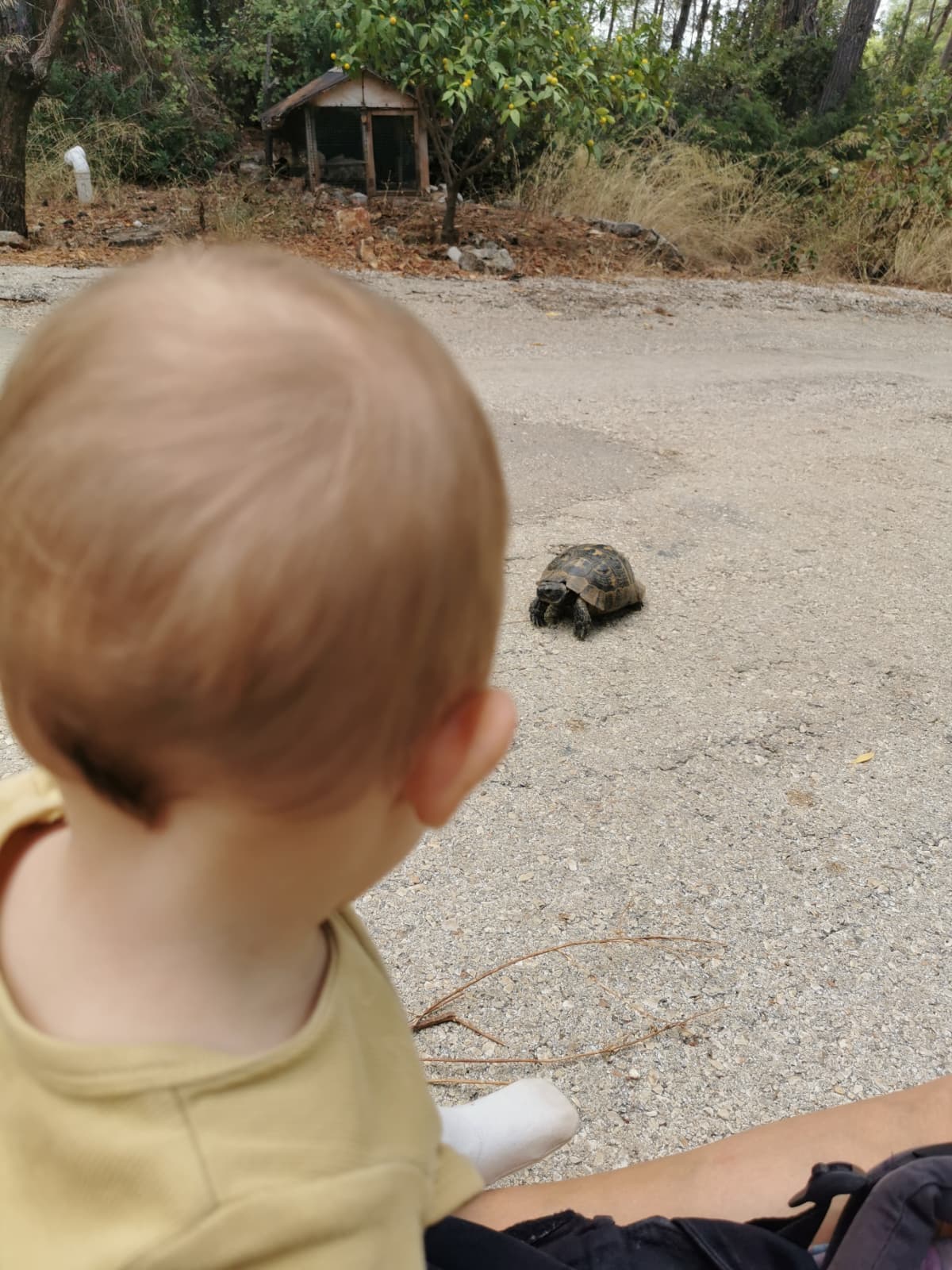
Lighthouse, Olympos and fire from the underworld
Another “star” stage was waiting. Perfect wild-camping spots under pines, the sound of the sea, all the way to the southernmost tip of Lycia. Here stands the Gelidonya Lighthouse, a beloved photo spot — the view over the scattered islands is simply breathtaking. Beyond the lighthouse the route turns sharply north, which will be the general direction to Antalya.
We crossed paths with several hiking groups; this section from Karaöz to Göynük is popular, sometimes with luggage transport. For a while a dog walked with us — which reminded us of Bruno, the dog in Corsica we accompanied for two weeks. This time it was a golden-brown female we called Laika. She left us again soon (thankfully).
We walked 21 km to Adrasan. Another highlight was a carob tree where we picked and ate lots of pods, and explained to some Russian hikers how to eat them — and, when asked, what matters for family life (we guess they’re on their honeymoon).
Because rain was forecast again for the evening, we wanted to rent a “hobbit hole” in Adrasan (a round mini-bungalow), but thanks to Cleo we got upgraded to a lovely little wooden apartment. Marie walked another 5 km to the supermarket, so we had fresh food for dinner — and finally time to write our latest blog post.
The next morning we finished the remaining 500 g of pasta and bananas and climbed again over a pass. There we met a couple from Karlsruhe who inspired us to slow down and give ourselves more time. After the descent we reached the impressive ancient city of Olympos, marvelling at sarcophagi, churches and bridges that lead right onto a beautiful beach framed by mountains. That mix of history and glittering sea draws plenty of visitors.
We ate gözleme, and the five-year-old daughter of the café surprised us by saying “Cleo Mouse” — something she must have overheard from us. We left the resort town of Çıralı fuelled up — with a new pack of nappies.
After 5 km we climbed to a highlight from the underworld: the fires of Chimaira — flames that have been rising from cracks in the rock for thousands of years. Incredible to imagine what earlier cultures thought when they saw this. Today there’s a physical explanation — and people sit there to roast marshmallows or sausages over the hellfire. At the top, on a pass with three fires, it grew quiet at sunset, so we pitched our tent. Only one other thru-hiker from Russia shared this magical place with us. The view stretched from the sea to Mount Tahtalı (sadly, with a cable car). In the morning we watched the sun rise over the sea while the fires still crackled, as they have for millennia.
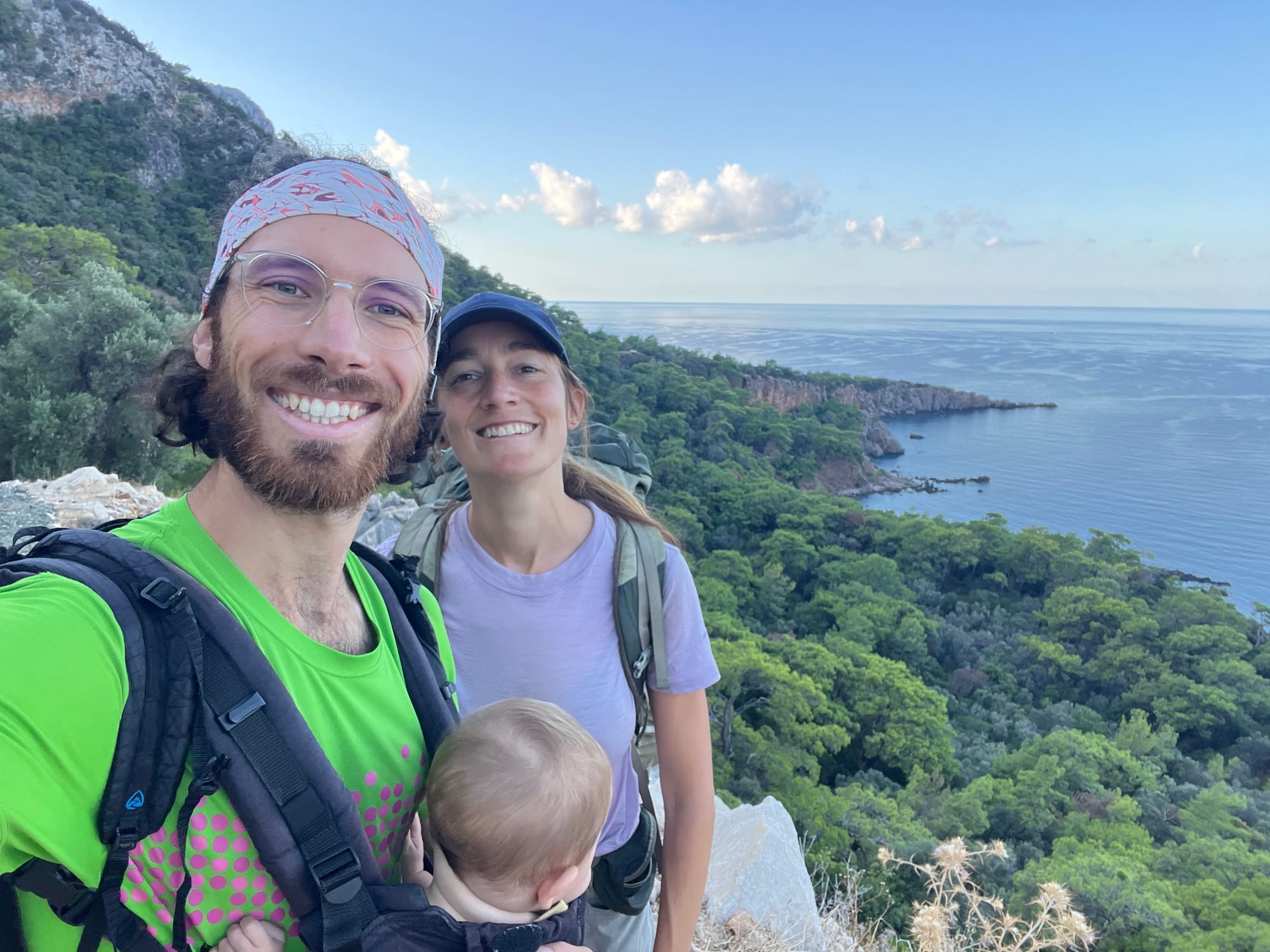
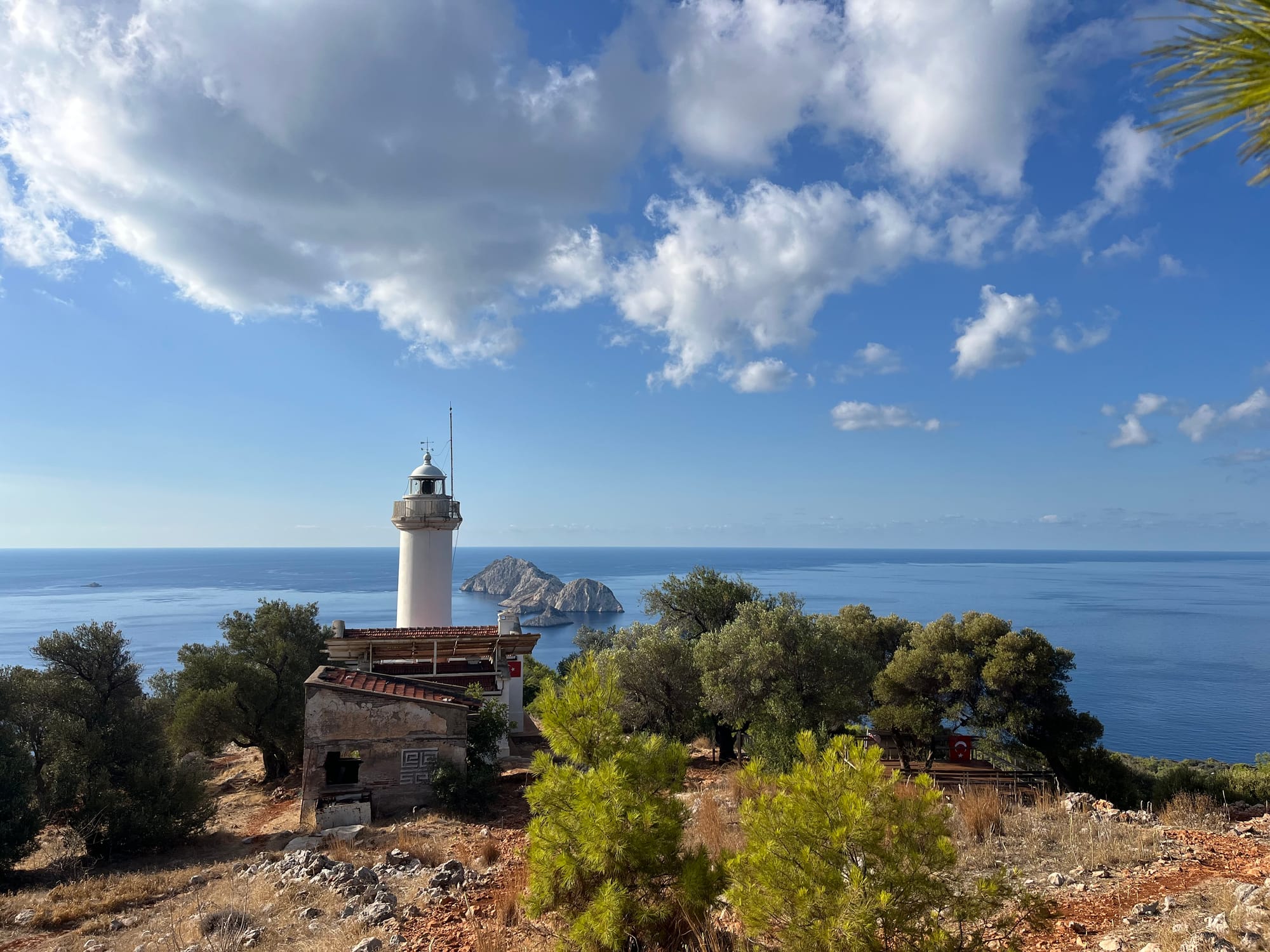
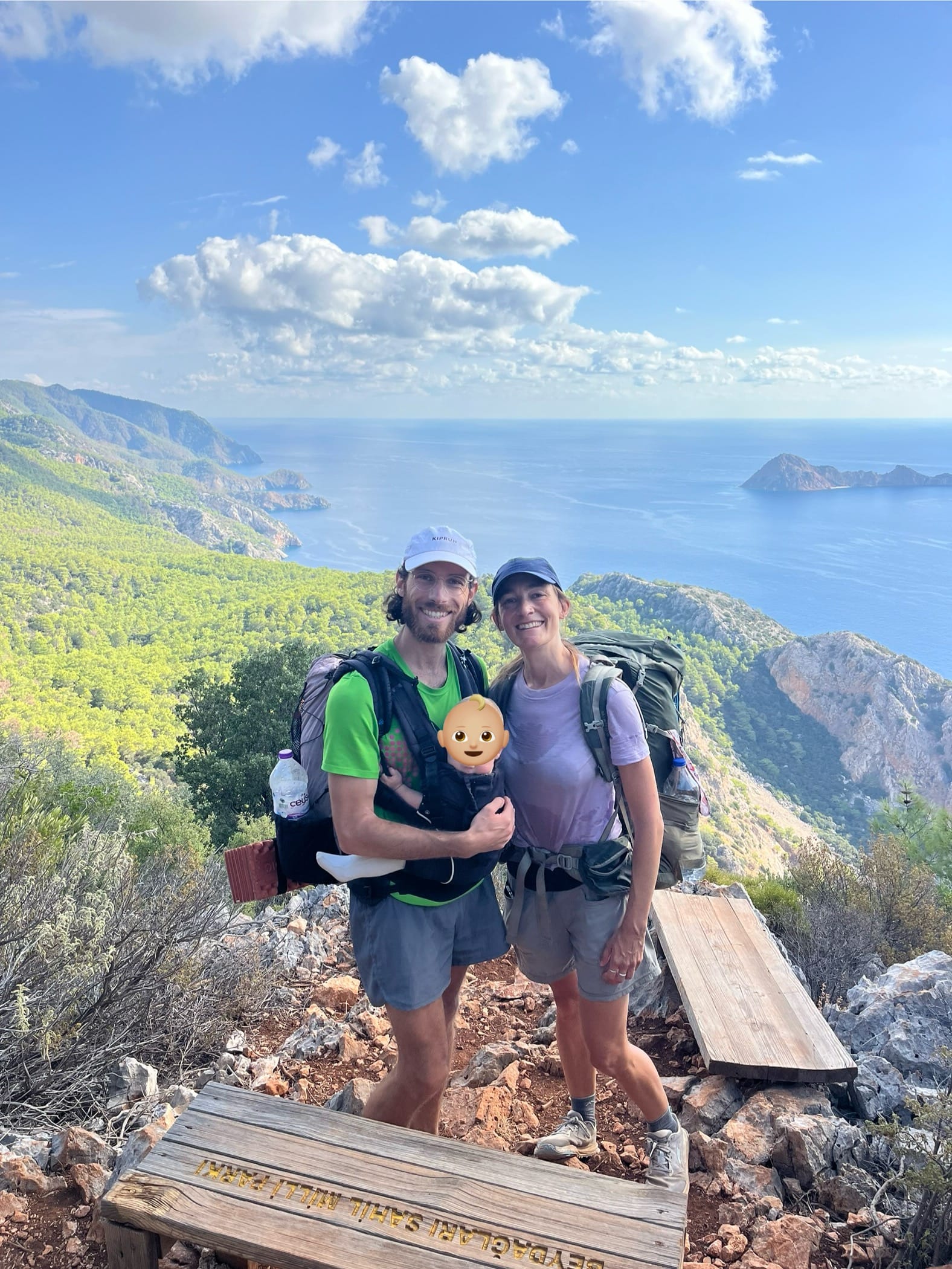
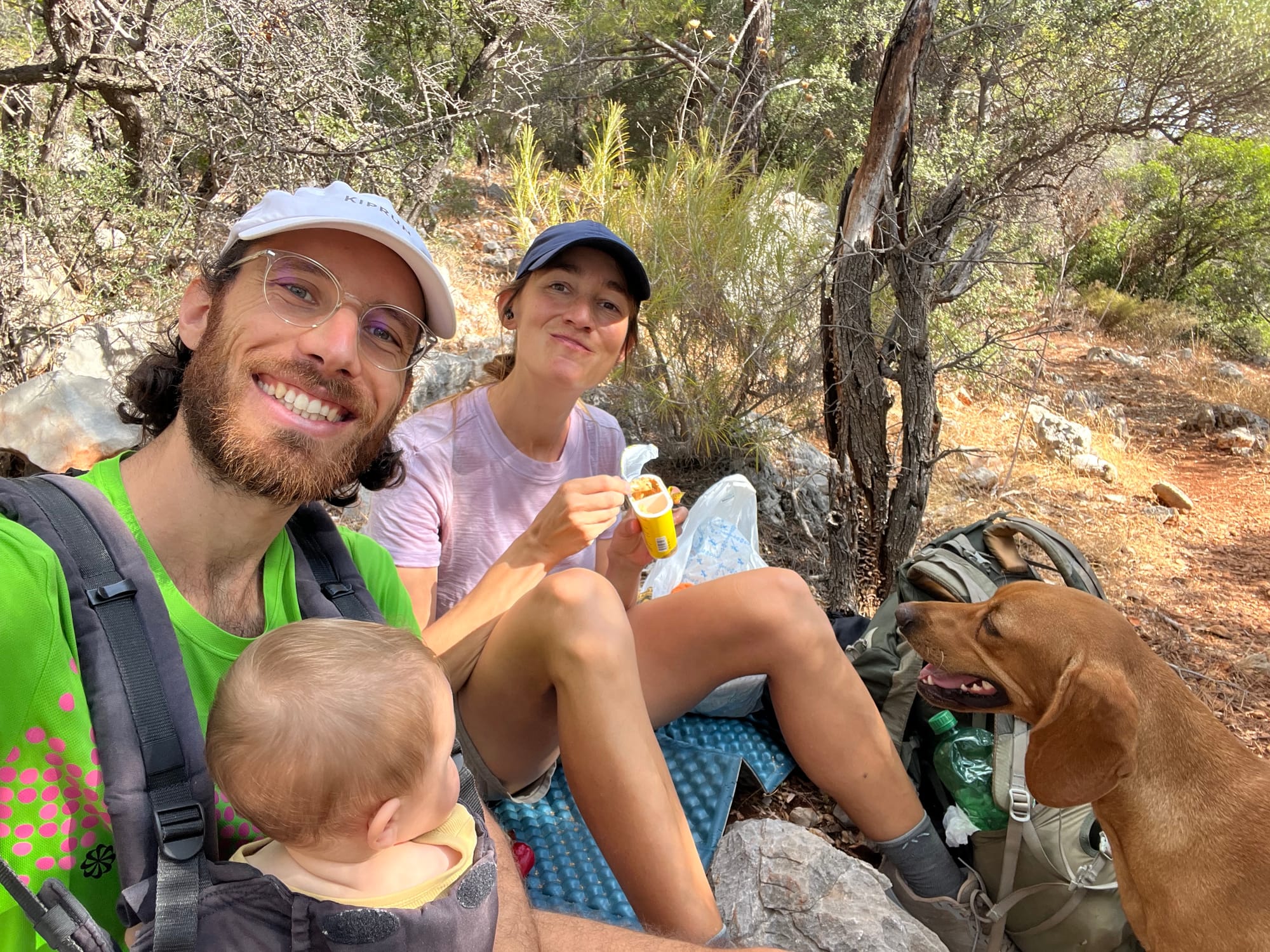
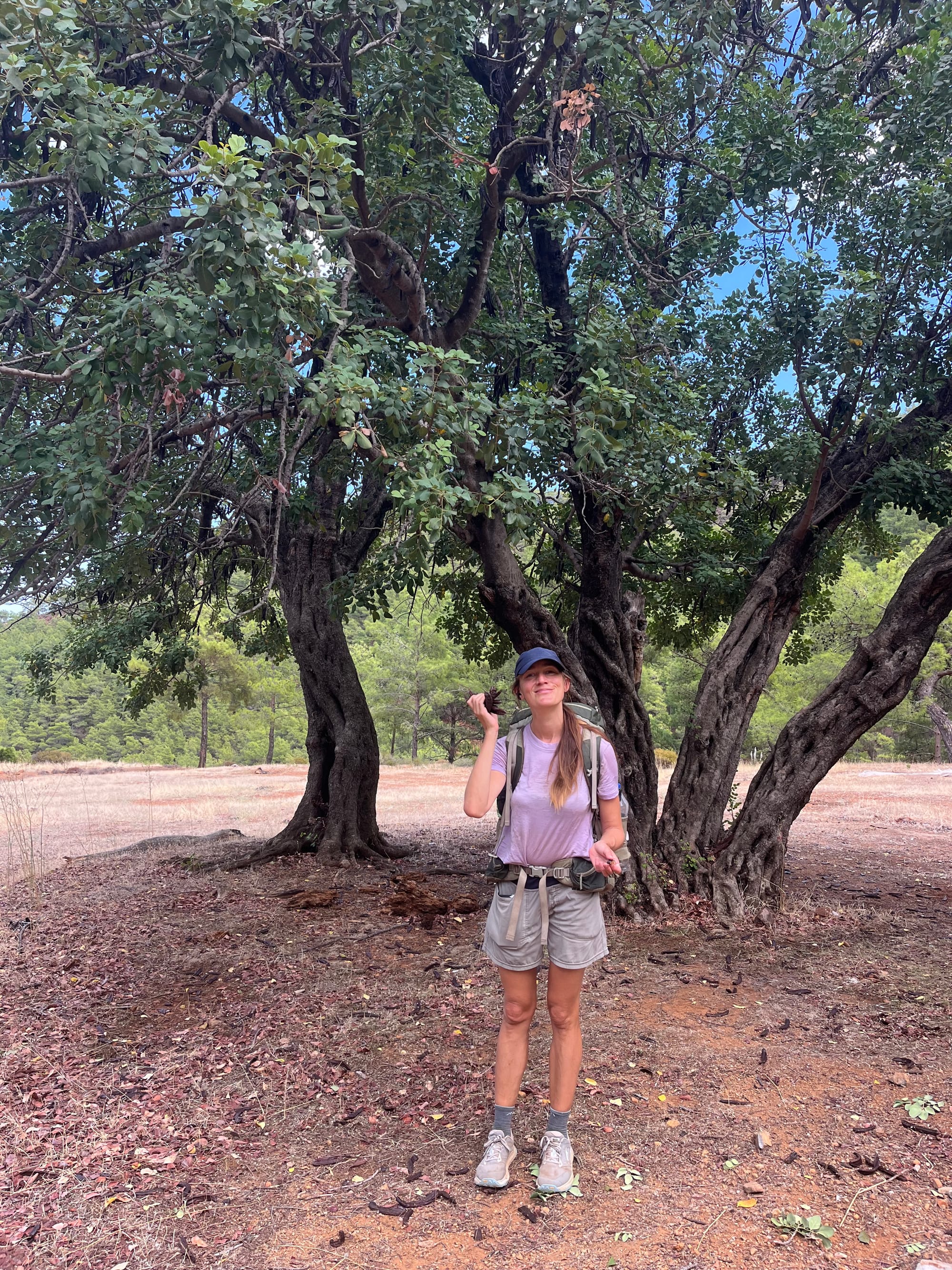
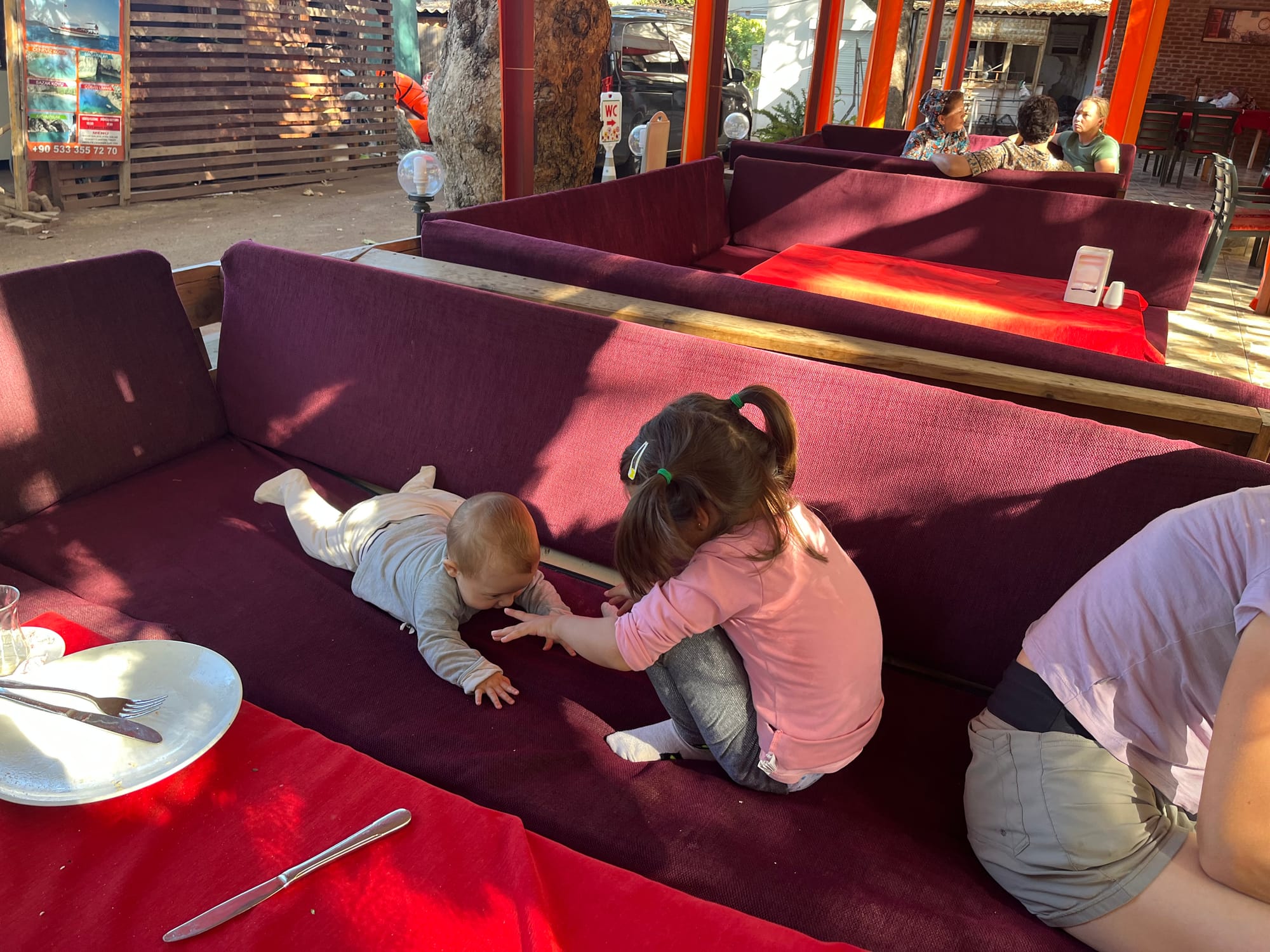
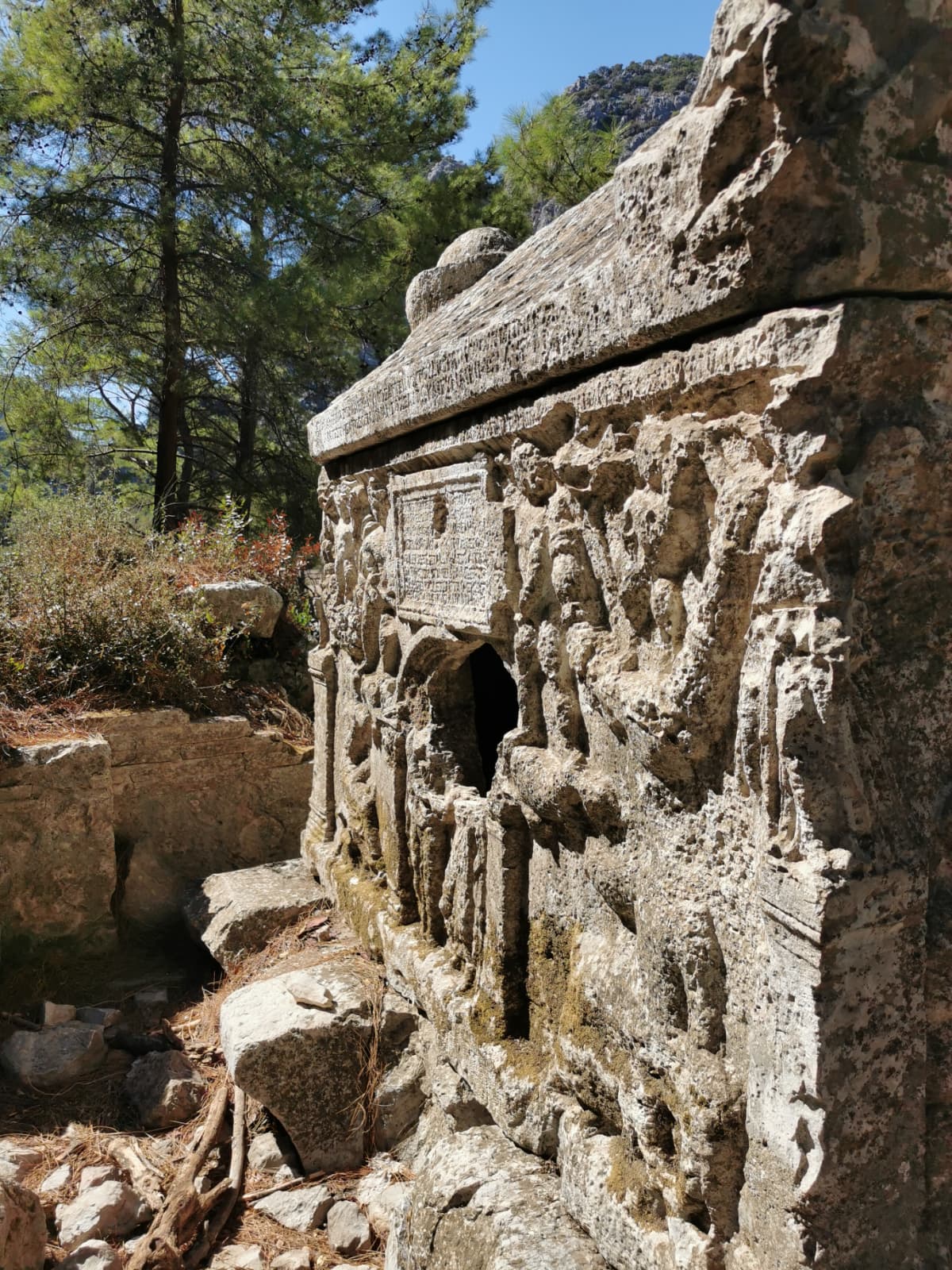
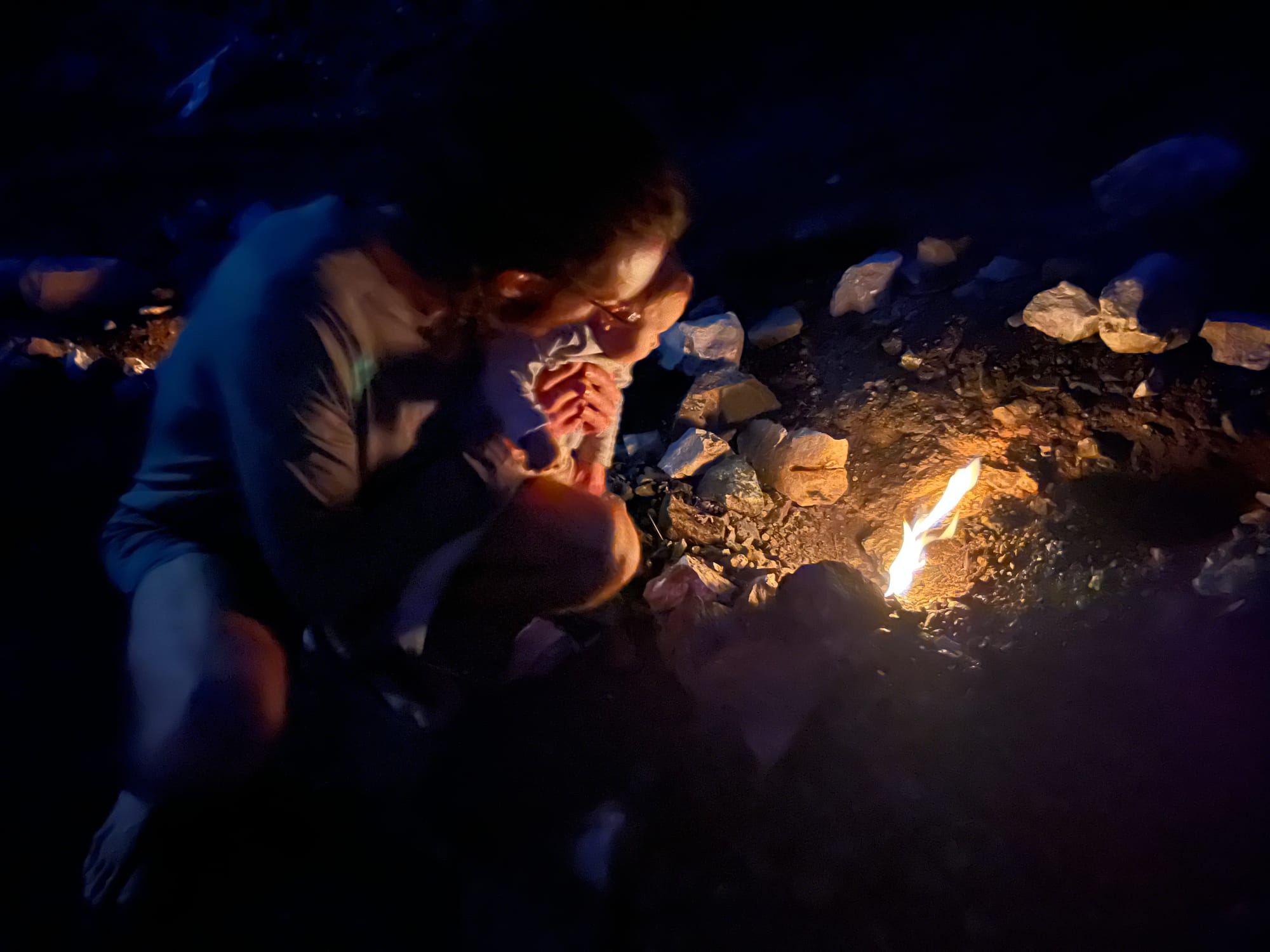
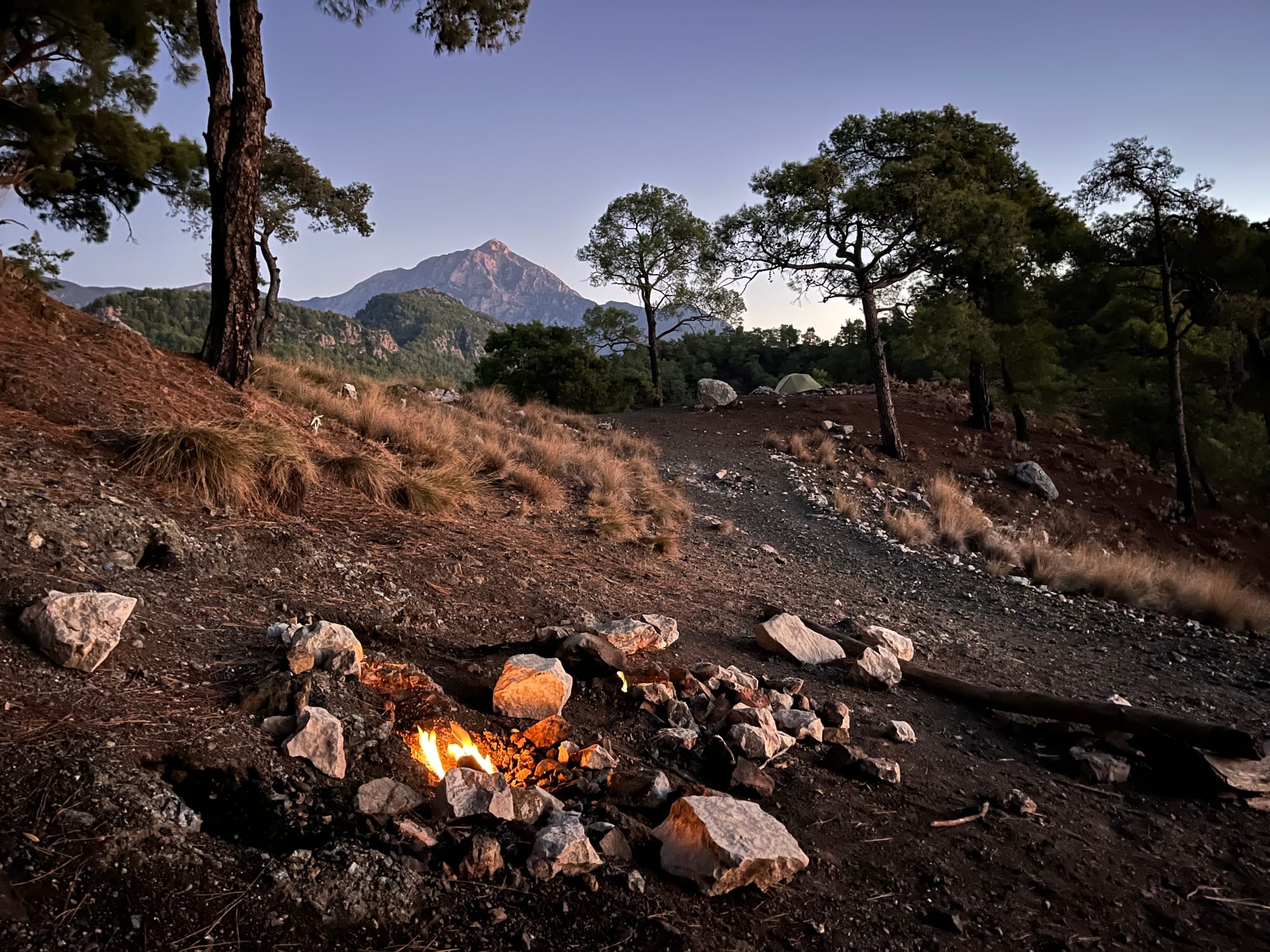
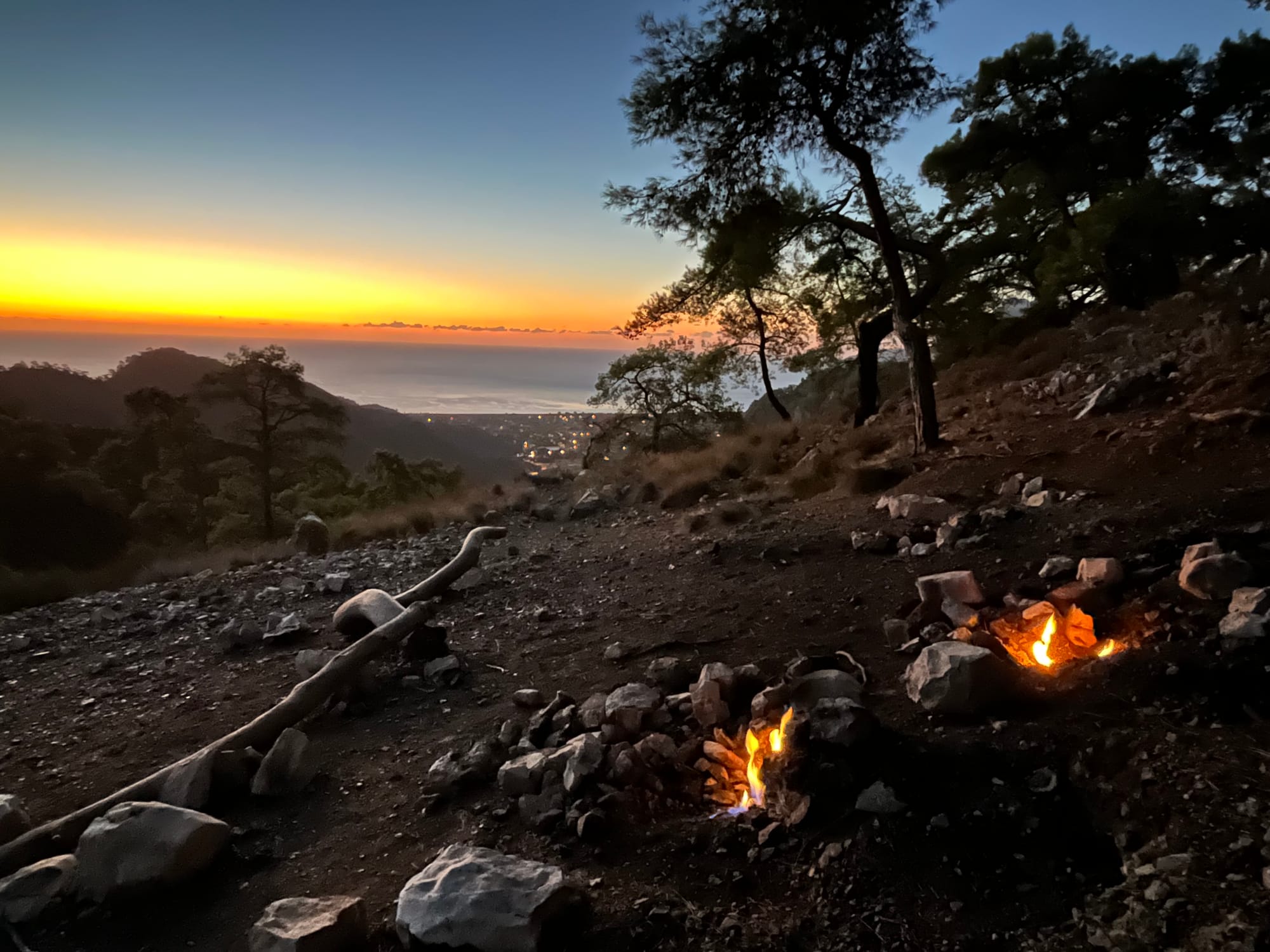
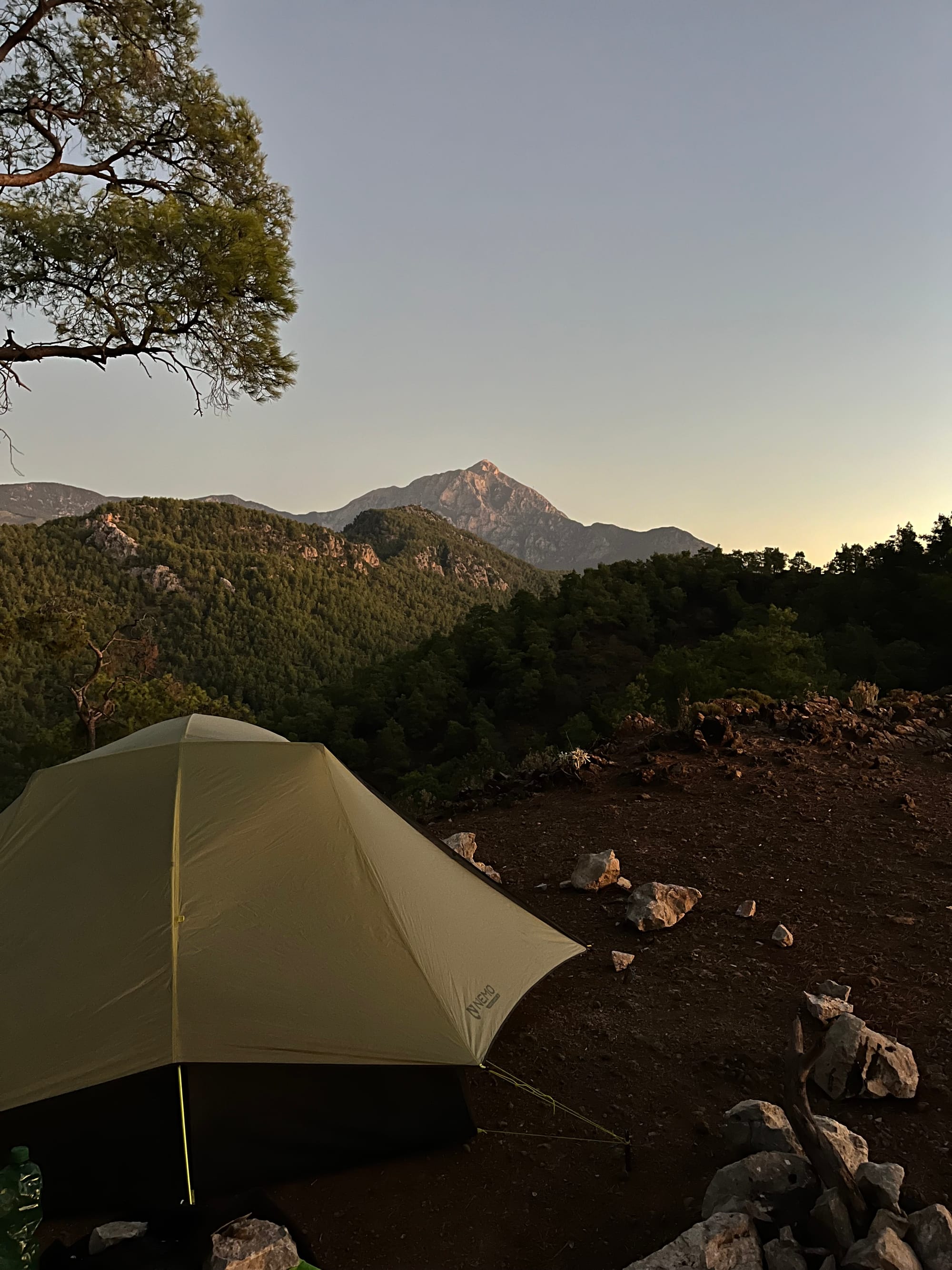
The queen stage over Beycik and a home in the now
We packed up and tackled a long ascent — almost 2,000 metres of climbing for the day. First on gentle forest roads, past olive and nut harvests, then breakfast on a wobbly balcony at the “Panorama Hotel” in Beycik under slowly yellowing plane trees. Kahvaltı is our favourite meal in Türkiye!
Then the trail grew rockier, the trees more twisted. At the top, the views were so good we kept stopping — around every corner a new photo. A sparse landscape with giant trees rising up, and the sea behind: grey meets blue meets red meets green.
After long breaks we still had almost 1,000 metres of descent. We didn’t want to sleep above 1,000 m with Cleo — too cold at night — so we headed down. When we arrived, the owner wanted double the camping price we’d agreed on the phone. Luckily we found another place to sleep — we carry everything we need and can sleep wherever we like.
We’re simply at home with ourselves, wherever we are. Cleo is too — happily playing with whatever she finds. Her favourite toy: empty or full water bottles. We also bumped into a Turkish hiker we’d met near Kaş and an Australian we’d met in Demre. Thru-hikers recognise each other — and it’s lovely to feel that trail community again.
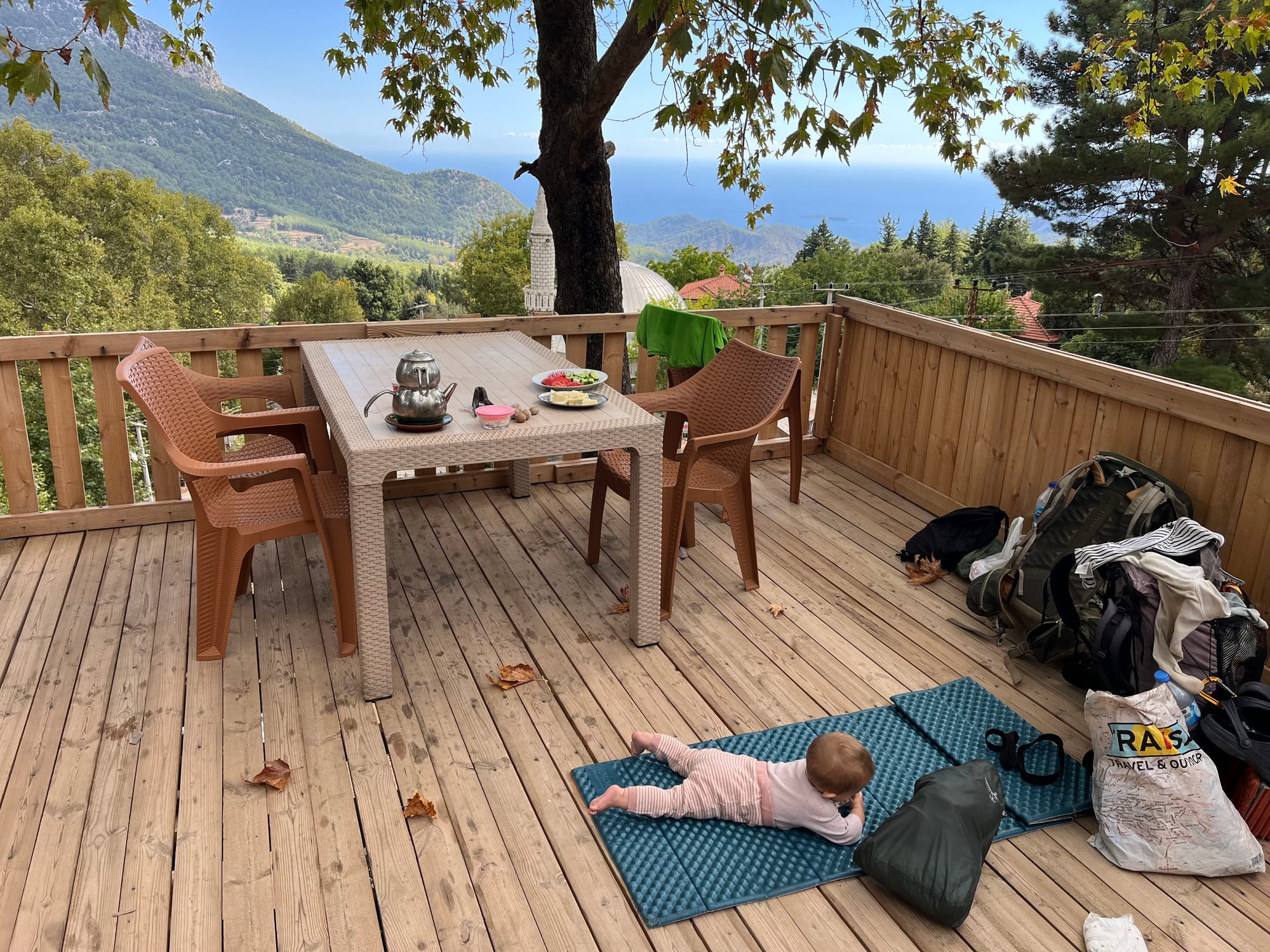
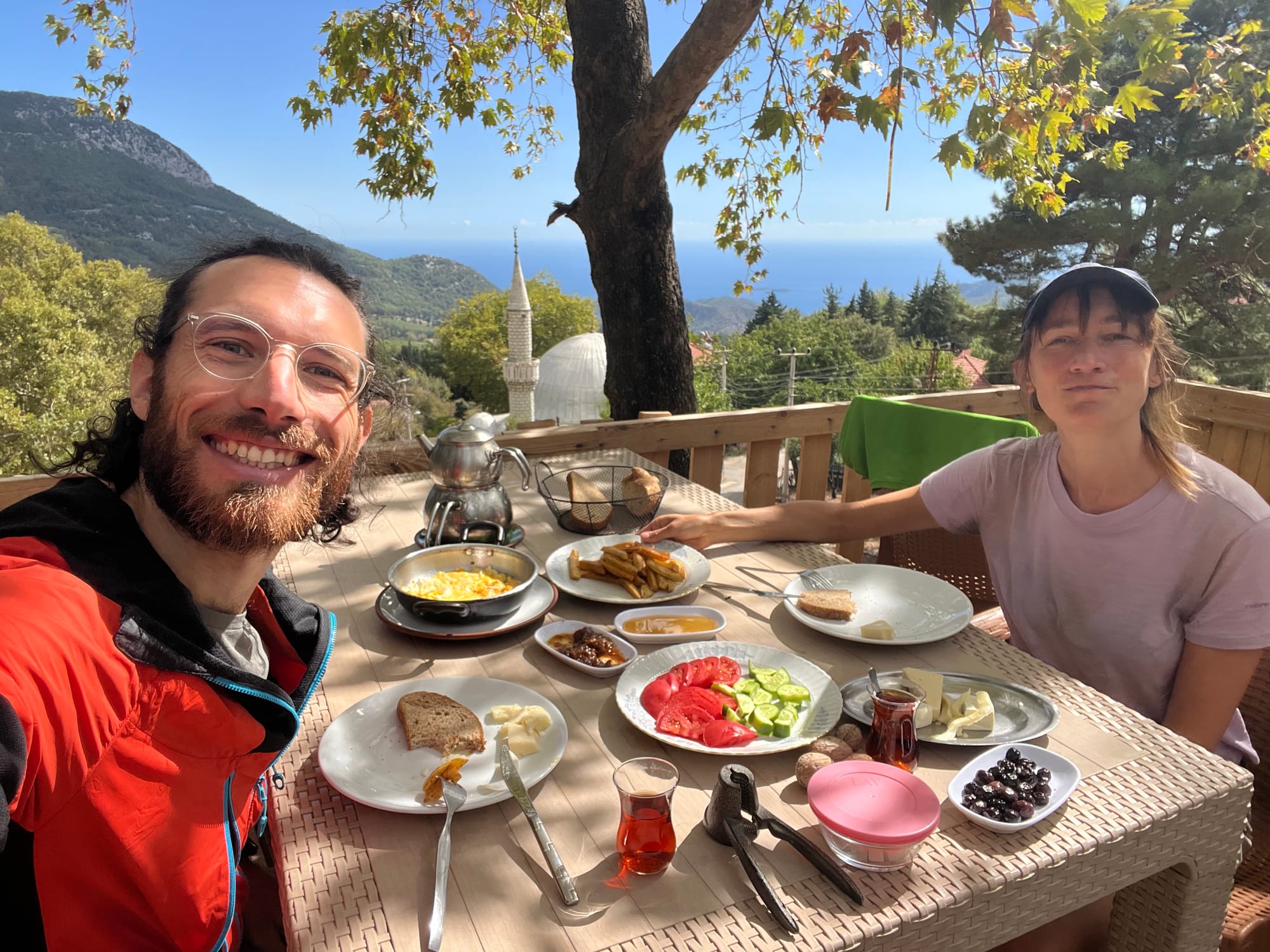
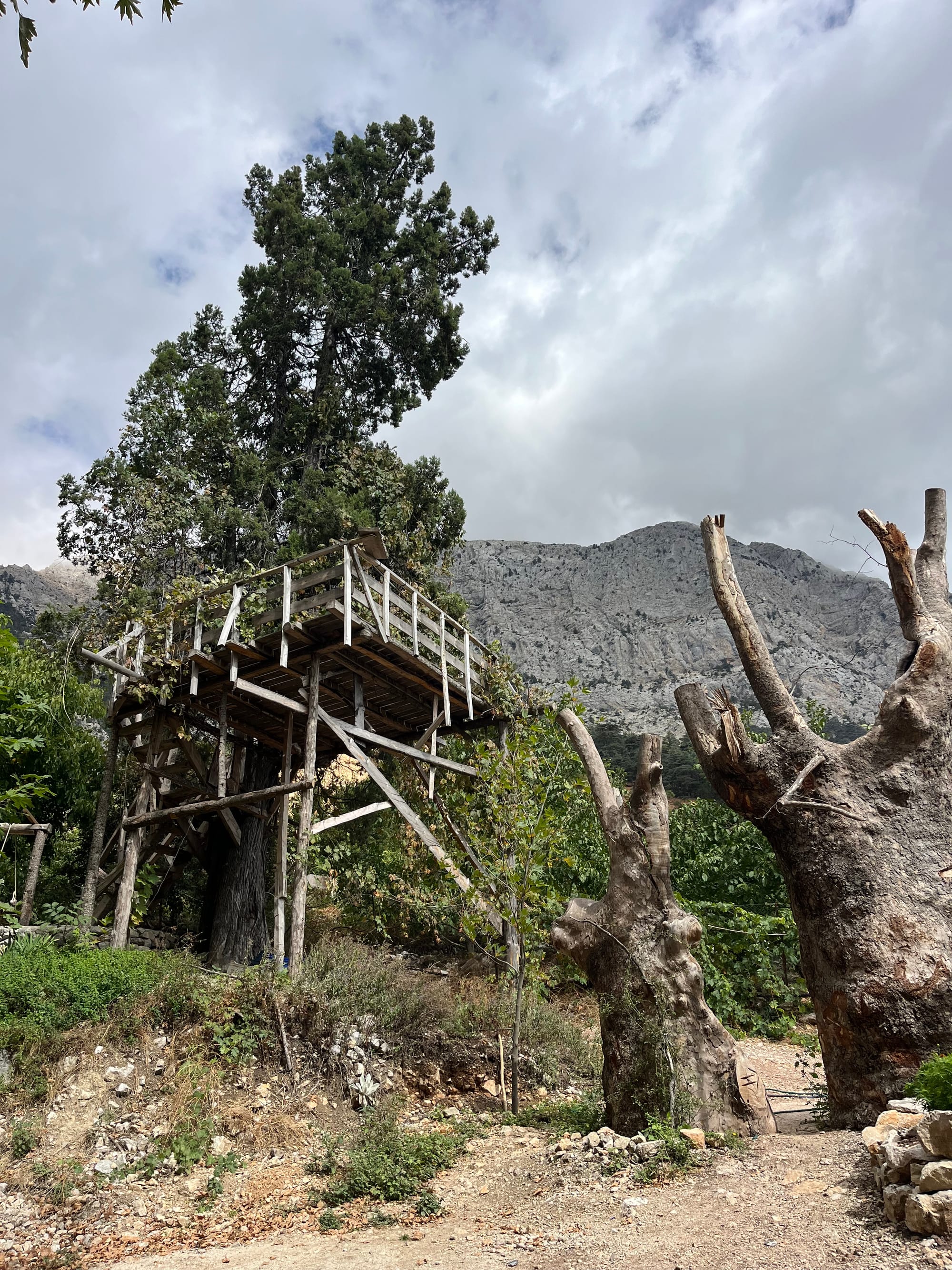
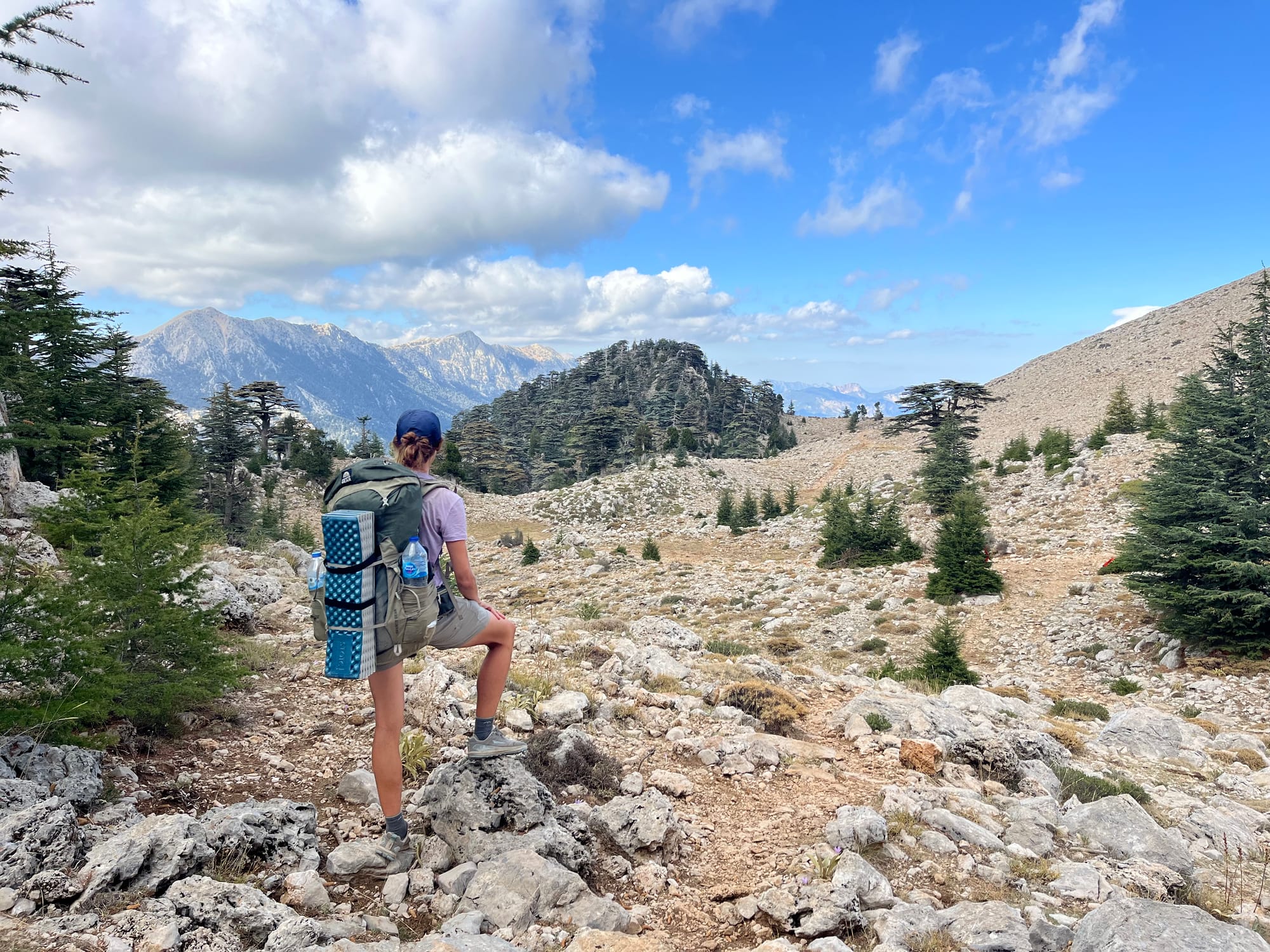
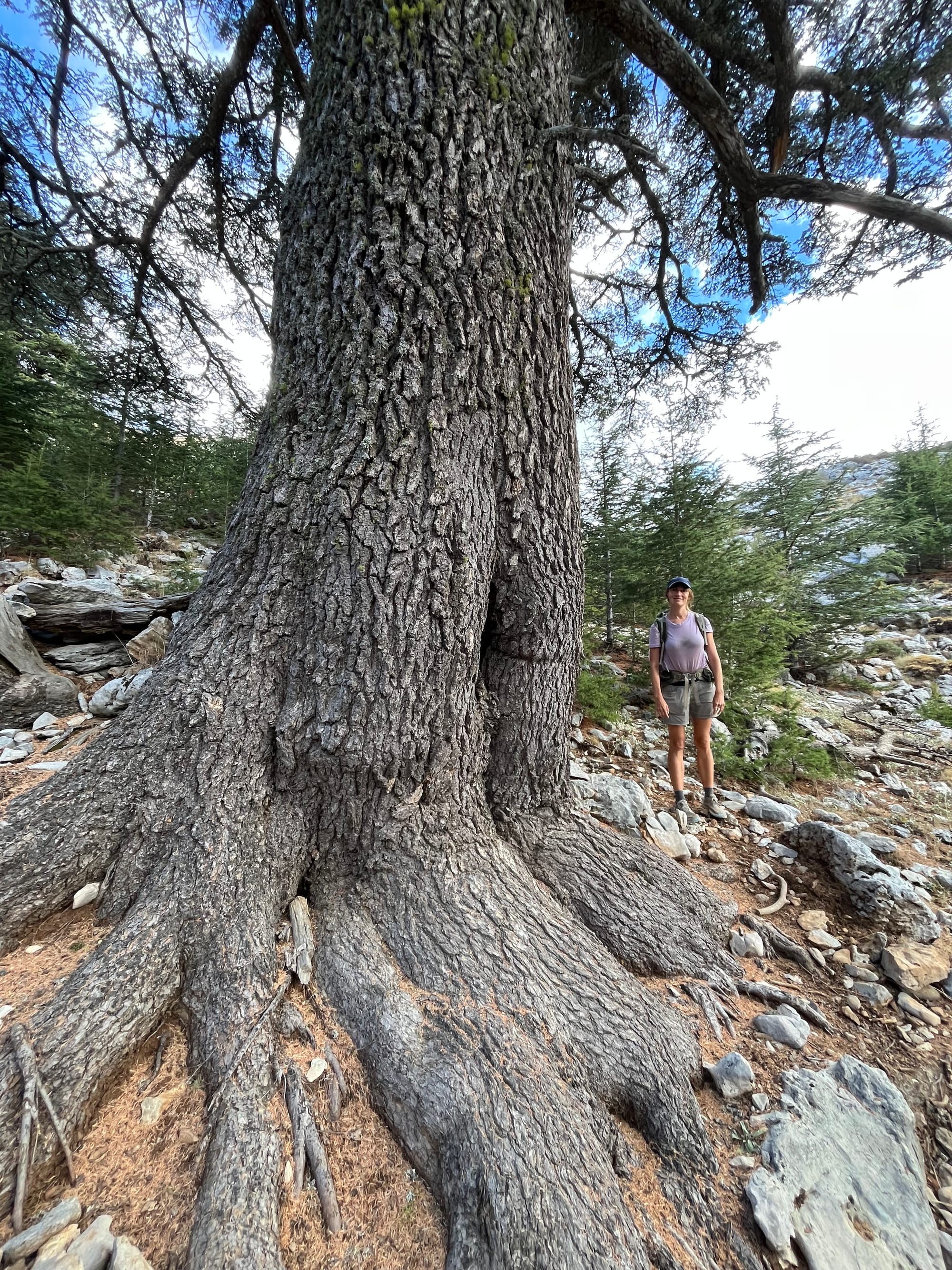
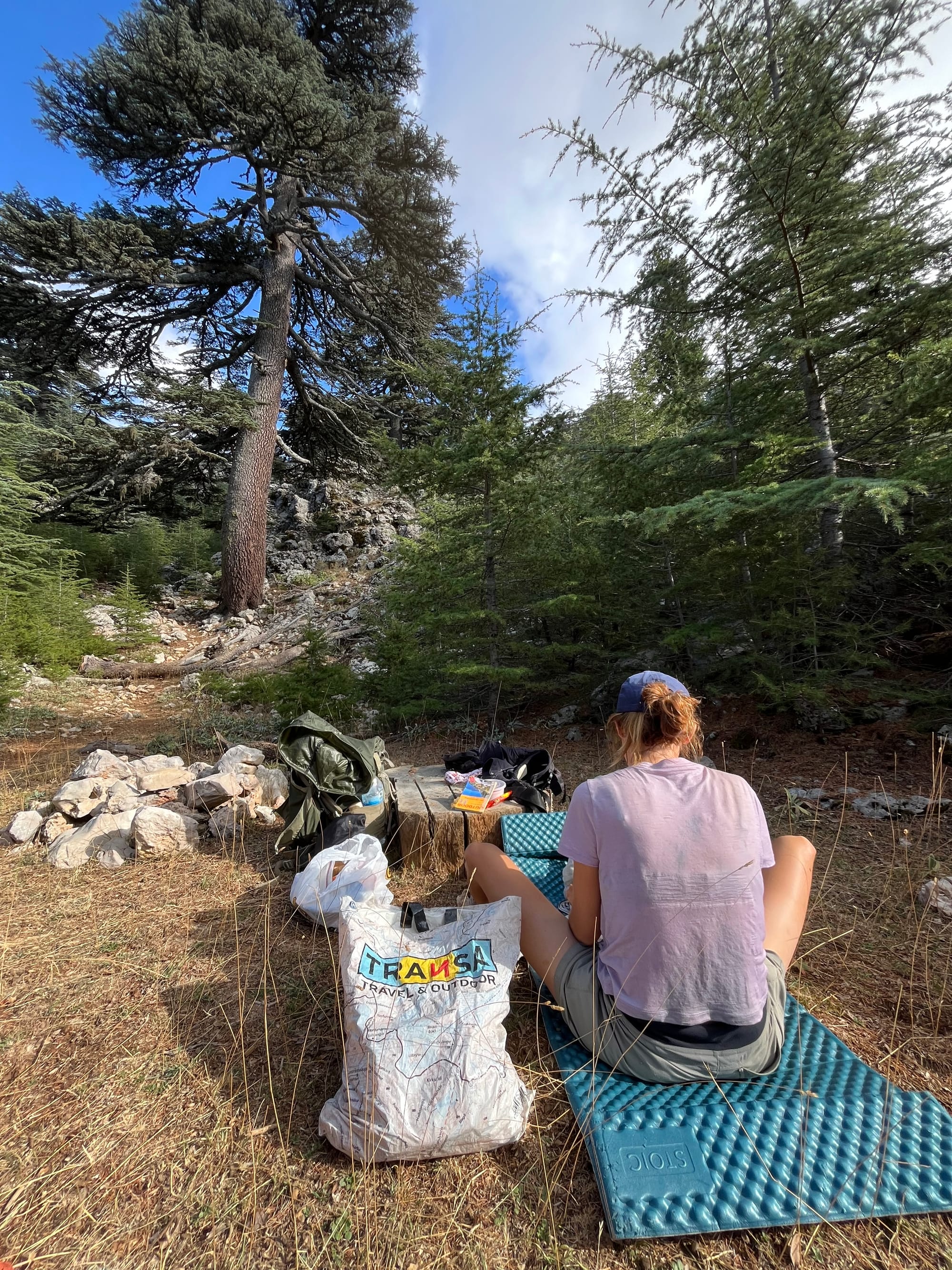
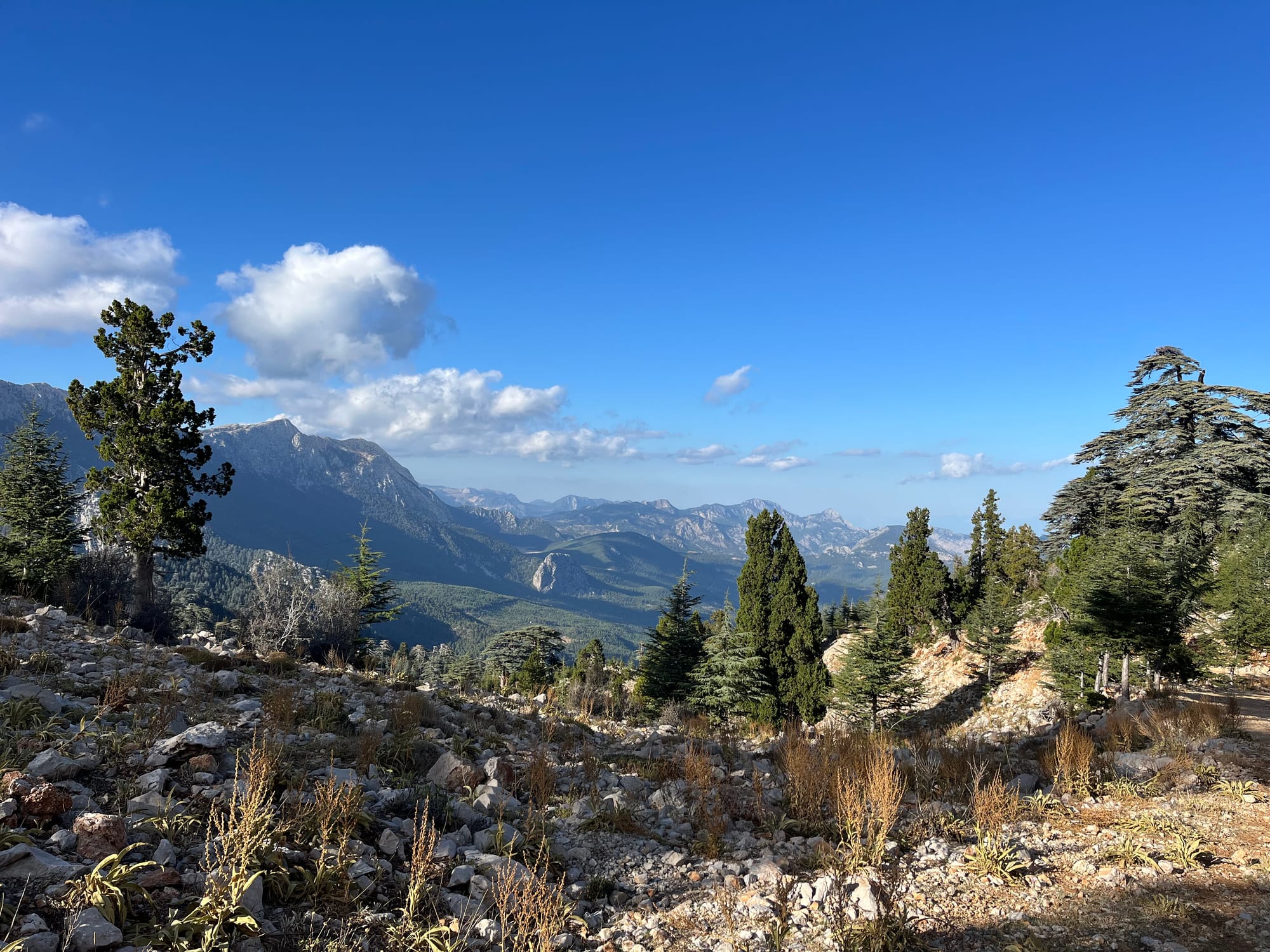
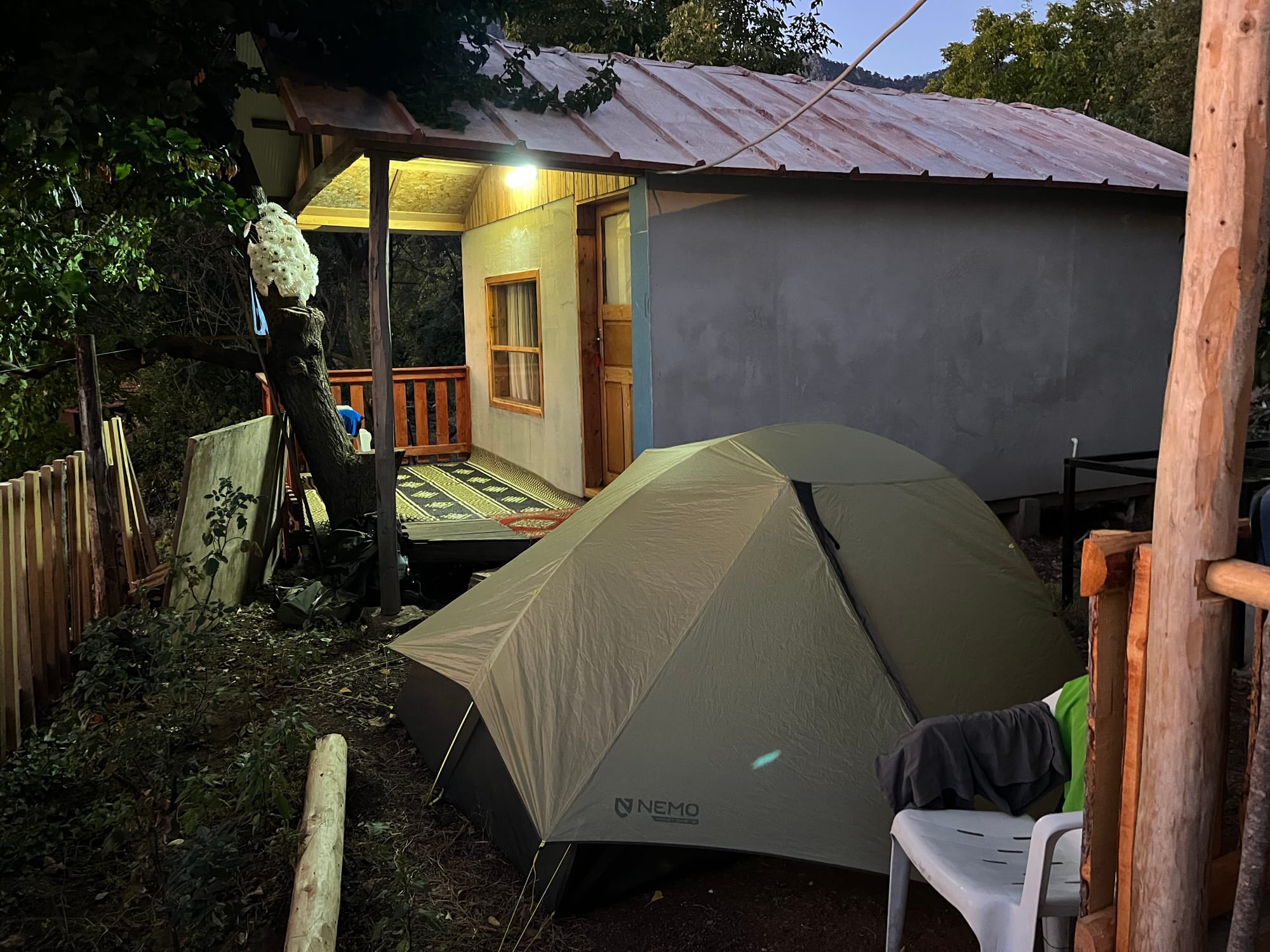
O
Conclusion
We’ve arrived — feeling at home between sea level and the high stages, both in the tent and in the friendly pensions. It’s wonderful to need so little and feel so richly gifted at the same time. We could happily keep walking like this for a few more months. 🌿
Would you like to know how our adventure continues, or receive a newsletter once a month with updates on new posts and pages on our website? Then subscribe to the newsletter.